#quite a few also appeared in twilight zone episodes!
Text
it kinda fucks me up seeing gifs and videos of the star trek actors and actresses in the media they made before coming on to trek because like... so many of them are in black and white?????? the original series is so vibrant and colorful and the lighting and sets are so pretty... these people started their careers before color was even a thing for tvs and that fucks me up to no end to consider


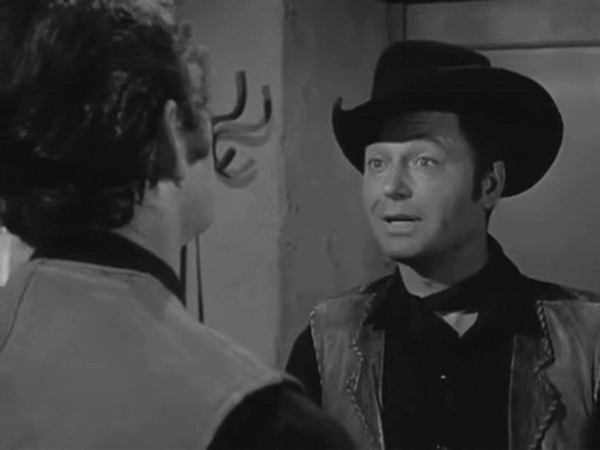
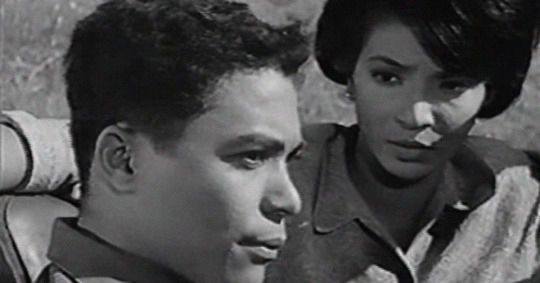
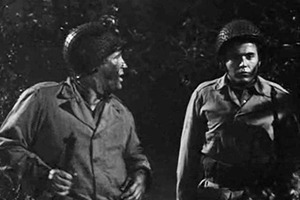
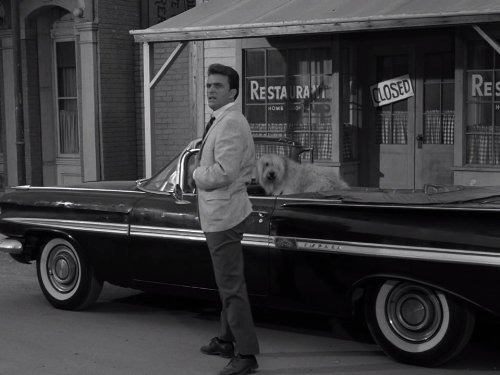

#star trek#the original series#tos#william shatner#leonard nimoy#deforest kelley#nichelle nichols#walter koenig#james doohan#george takei#apparently quite a few of them actually began their careers at the same time around the early 60s#deforest began his earlier but still#quite a few also appeared in twilight zone episodes!
3K notes
·
View notes
Text
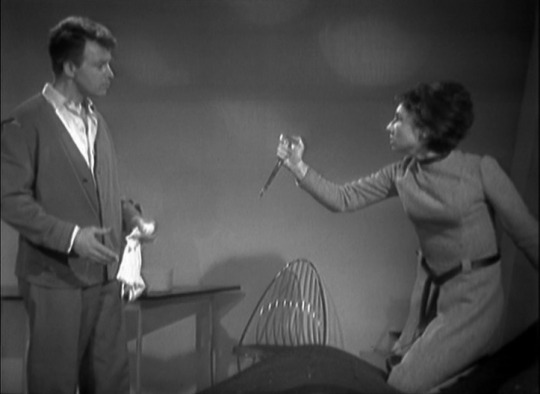
Rewatching Classic Doctor Who, some episodes I haven't seen in years, some of the animated reconstructions I haven't seen at all.
The Edge of Destruction AKA Inside the Spaceship AKA Serial C
Originally commissioned to fill a gap to make sure Doctor Who could make it's bare minimum 13 episode order and written in only two days, this story is quite a departure from the previous two.
After the standard (barely historical) historical adventure and the standard sci-fi bug-eyed monster episode.. we get this. Something closer to The Twilight Zone or Outer Limits than what we've seen so far. But as shabby as it is around the edges (apparently it is the cheapest Doctor Who story ever made), it works well and more than that established right away that almost anything can be a Doctor Who story. One of the best things the classic show has going for it is that it is closer to an anthology series than a standard television drama. Sometimes you get sci-fi, sometimes history, sometimes horror, sometimes comedy, sometimes tragedy, sometimes wonderful satire, and sometimes.. sometimes you get The Twin Dilemma. Well, just once, but once was enough.
At the end of the previous episode, what appeared to be an explosion rocks the TARDIS and we start with the crew unconscious. Ian and Barbara briefly have amnesia, the Doctor has a head injury, and Susan absolutely loses it. This gives Carole Ann Ford a chance to act for a change, which is nice. It also gives Doctor Who it's first official "too violent for kids" moment, as BBC execs objected to the scene above where Susan threatens Ian with a pair of scissors, prompting a hasty apology from Verity Lambert
While the crew recovers, paranoia sets in. The Doctor makes some wild accusations. Barbara takes them personally. Ian tries to strangle him, which at this point seems fair, but really was possessed by a sensation to wrestle him away from the console? It's ok Ian, we all want to strangle him at this point you don't need excuses. Eventually Barbara starts to piece together that there's a hidden message... a warning.. from the TARDIS. The TARDIS's sentience comes as a surprise to everyone but we'll have to wait 40 years to see that idea through to it's resolution. After that everything gets resolved rather quickly, a button had been jammed down on the TARDIS console and so, logically, the TARDIS was going to take them all the way back to the Big Bang. For the first time, but not the last time, anyway. The crew has bonded through shared trauma and are now the best of friends. Which sets up much better relationships between the characters going forwards. Nothing stronger than bonds forged through trauma.
Wonderfully surreal at times, with an amazingly discordant soundtrack keeping things on edge, it's a fun little story. The only story to take place entirely in the TARDIS, the only story to feature only the Doctor and their companions, the first of a vanishingly few number of stories with a zero body count. There's not even a traditional villain/antagonist, really, just 'human' paranoia. Still a fun watch and establishes that the boundaries of this new show can be far, far beyond what was originally envisioned.
Next up, however, a hasty reversion to what was originally envisioned. The entirely missing Marco Polo.
#doctor who#classic doctor who#first doctor#ian chesterton#barbara wright#william hartnell#carole ann ford#jacqueline hill#susan foreman#william russell#doctor who rewatch#Edge of Destruction#Serial C
20 notes
·
View notes
Note
Hi Lucy
Random musing but there have been so many things over the past three weeks that feel like a deliberate attempt to rile up the fandom but from the outside appear minor and feed the fans are unhinged narrative. Things like the pumpkin pics, Broadway pic (that was unbelievably out of character for how he uses is IG) even things like seeking you out in order to block you which generated such a ripple across the fandom and now today the house thing. Its been almost daily over the past few weeks. Something is just not quite adding up whether it's PR or they truly are loves young dream....
Not sure what the endgame is or whether its just about boosting relevance on the algorithms but this all feels like living in a twilight zone episode (although there have also definitely been lines crossed by some fans)
There's a analogy about biting the hand that feeds you that a certain someone's team might want to remember
Sorry just thinking out loud, feel free to ignore!
.
4 notes
·
View notes
Text
StreedTV Reviews: The Outer Limits #1 The Galaxy Being (1963)

Review#1
I've heard of the outer limits for a while but until now I've neglected to actually watch it but some people compare it to the twilight zone since it's an anthology show
I really enjoyed the first episode, it perfectly sets the tone for the series, the design of the mysterious alien is so eerie and truly unfamiliar
while it appears sinister it's actually not an inherently evil creature, it's a nitrogen based being purely made out of radiation so when it encounters hostile people it instinctively tries to defend itself

Alan Maxwell is a very engaging character himself, he's a dreamer who longs to explore and discover the secrets of the universe, he's played brilliantly by Cliff Robertson who starred in two episodes of the twilight zone
my favorite scene from the entire episode is when Alan first makes contact with the alien, they're conversation is so engrossing and it genuinely feels like a realistic conversation between an alien creature and a human being
another aspect i appreciated about the episode was the atmospheric score, it really complimented the episode well, I also really liked the ambiguous ending where it's made unclear whether the alien survives or not

as for my criticisms the concept for the episode sounds intriguing but the execution is quite standard and somewhat generic, even though the effects where revolutionary for the time it still aged quite poorly but I still appreciate the alien's enigmatic appearance
I also felt the alien's speech at the end was a bit on the nose and every actor that isn't cliff robertson does a mediocre acting job
over all, this was a fantastic introduction to the series with a few issues regarding it's execution, among other things, however the entire time i was thoroughly entertained and I'm quite excited to venture further into the outer limits

Rating: 7/10
1 note
·
View note
Text
I’m back with another episode of “I talked with @llamagoddessofficial and now I have to write something” dsfdkglh ok here you goo
also if you have thalassophobia/fear the deep sea especially you should probably not read this, because that’s where this takes place, and there’s a bit of a scary scene where reader’s in danger so beware!
======
900m - 2955ft . . .
You watched the computer closely as you make your descent into the deep, empty waters.
You’re a researcher from the Ebott Aquatic Research Institute, and you’re currently aboard a research submersible, and you’re here to observe marine animals up close and personal. The advantage this had over robot-controlled subs was mainly visibility, and that you could react and adapt much faster.
You were excited to be granted the opportunity of something so... monumental, not just in your career, but to actually be here, in the deep sea where so few have ventured.
Now, traveling through the twilight zone... you were still excited. But you were also building with nervous energy, with not much space to move in, surrounded by darkness, and...
You’re alone.
You knew that far before your trip. The sub was designed for one person, after all.
(It had a main front “window”, shaped like a dome that provided a sort of “360 degree view”. The control table sat at the base, with you sat right behind it. It’s sides were metal and had side windows as well.)
But now that you’re here in the deep, far from any other human... from any other living being, seemingly surrounded by nothing but vast, empty waters... it’s quite the experience.
When you went down the continental slope, it looked more like the moon’s surface than anything earthly, not to mention the various creatures that passed by your lights. The bioluminescent creatures especially (you were lucky to come across a giant siphonophore on the way down) made your descent feels like you’re traveling through a portal to another world, unfamiliar to your own.
Surrounded by darkness, the only lights coming from your sub, with only the company being the sounds of the water outside, along with the little beeps the computer would make... it felt lonely, and to be honest, made you a bit nervous.
But you were still thrilled to be here, anyway.
You’ve travelled maybe for a couple of hours down here, and you were closing the distance that marked the transition from to the midnight zone. As you keep descending, you keep seeing less and less creatures. You haven’t any in over an hour by now.
950m - 3120 ft . . .
You watch the marine snow fall, and you’re feeling a bit restless from the inactivity. You’re nearing the end of your journey; after you reach the midnight zone, you’re supposed to maybe stay for 15 minutes before returning to the surface. You hope you’ll see something before having to return.
You’re just starting to wonder if you could place your elbow somewhere on top of the controls without pressing any buttons when you notice something moving around through one of the side windows of the submersible.
You immediately sit up as you lean into the window... two dots of white were floating by in the distance, and from the way it moved you know that’s not marine snow.
It’s... glowing? For a second, you think they must be eyes- only to shake your head on yourself. That can’t be it, can it? It’s probably some fish or other that had lights on its head and tail... who knows, maybe you’ve discovered a new species?
Yeah... that must be it. You try to reason with yourself, even as your heart starts to thump faster, keenly feeling like you’re being watched.
You hear the water burble and swish around you, and it sounds like... something big swimming around you.
You swallow nervously. When you keep staring at the white dots (lights?) you start to feel anxious, but you keep watching anyway. You almost jump in your seat (almost hitting your head) when you start to hear some sort of rumbling(?) coming from the outside. It was low and almost resembled some kind of old engine. Maybe it’s because you’ve been in the quiet for so long, but it felt like the sound shook you.
You try to keep your eyes on the- whatever it is out there, wary of what it actually is. Is it just you, or are those lights getting bigger? Closer? You find yourself leaning a bit away from the window, and watch as they slowly float its way above the sub, out of your view. You turn around and lean to the other window, expecting it to appear on the other side- when you see something out of the corner of your eye.
You gasp when you see a shadow slowly float its way across the lights, still a bit away from your sub. You can’t see the creature’s head, but you see... tendrils? Slowly making its way upwards to the left, before disappearing back into the darkness.
“... fuck,” You say emphatically as your brain provides you with the thought of is that a giant predator? It was attracted by your lights and is trying to figure out what you are. You might be in danger if it decides to attack.
You know it’s not very logical of you to assume that but... better safe than sorry, right?
Your eyes dart to the control panel. You turn off the engine before turning to the light switches. You flick them all off, including the internal lights, and you’re plunged into a world of darkness.
The constant whirring of the engines shut down, and for a few moments, you only hear the sound of the water swishing around you, that rumbling sound gone.
... and then you heard a sound that resembled an otherworldly shriek(?!) before it returned back to that rumble, but this time, it resembled a growl. Your heart leapt in your chest as you look around for the creature.
You spot the white dots, and it’s definitely closer. Your breaths are shallow as you’re praying to whoever’s listening that it’s going to leave (the behavior of deep sea creatures are largely a mystery, but it looked like a predator stalking you)... widening your eyes when you see it.
A string of light appeared from what seems to be a spine(?) all the way down, and you see that it does have tentacles, dotting across it up until the tips, lighting a very dim blue (if you weren’t surrounded by pitch black darkness, you probably wouldn’t be able to see it) that fades in and out of darkness.
In this poor lighting and your human eyes, you can’t really guess what the creature is aside that it had tentacles, but if you had to guess it’s size... it was about the size of the sub? Bigger?
You don’t know how far it is from you so you don’t know exactly, but from the sounds it makes and the brief shadow you saw earlier, big is probably not far off.
You could only hear the sounds of your own breaths as you wait it out, always watching where the glow was, wondering if its getting closer or if its just the trick of your mind. Your eyes weren’t built for this...
You stare at the feeble light for what feels like hours (though it must’ve been just a few minutes at most) when you realize you can’t see it anymore. You look at the windows, and your eye widens instinctively (you’re not going to get more light by doing that). You strain to see if the creature’s still out there, and you hate how completely helpless you feel because you swear you could see shadows just beyond the window, but you don’t know if you’re actually see something or it’s just your brain trying to make sense of the complete darkness.
Maybe it’s gone...?
You feel your whole body flinch when you see a blink of light nearby, and when you turn you see it’s your depth gauge.
1000 m - 3280 ft . . .
The midnight zone.
The glow of the numbers, resembling a digital clock seems like the brightest thing you’ve ever seen as you lean in to it. You turn your head up towards the main dome-window of the sub...
This time jumping when you see the two definitely lights looking back at you, closer than ever before. It was stationary now, and you realize those ARE eyes when you see a wide, gleeful grin appear just below it.
Suddenly, you see how the creature comes back to light- this time much, much brighter than before. It shoots like lightning, flashing from its spine down to its tentacles- which you realize were completely enveloping your submersible.
It’s suckers made rings of light on the windows and were squirming all over, and you scream when you followed them back to its owner.
It really was a skeleton- ribcage, arms and all. It (he?) almost looks like a human skeleton, except that his skull was much rounder, his jaws were fused, practically all of his bones were thicker than any skeleton model you’ve seen, and his hands were fused to make palm-like shapes.
And they were pressed right onto the window in front of you.
That clicking, rumbling sound started up again, and this time it actually shook you, coming from his skeletal part. You see how his expression changes into something dreamy as he tilts its skull and his eyelights settle on you. His cry starts to sound lighter, joyfully(?), as if he was happy to see you.
He closes his hand around the window and you see his tentacles (each about as thick as your torso!) waving from somewhere a human pelvis is supposed to be. You look back up to the skeleton when you hear a whine coming from him, a distressed look now taking his face as his fingers curl into fists in front of you and his tentacles look even more restless.
You lean away, into your seat. There’s this look of... want on his face, obsessively looking at you. Your heart sinks into your stomach when his face turns into something dark... angry... another frustrated cry coming out of him when he looks around you, and he tries to sink his fingers into the window.
You’re confused as to what he’s doing when you hear the metal around you groan under a pressure- a pressure he’s applying.
This sub was made to withstand extreme pressures, and he was able to to put it under stress.
And it looks like he’s trying to crack it open like an egg.
Adrenaline pumps through you and you throw your hands onto the control panel- if he can do that, now you’re in real danger! - and you turn the engine and lights back to life and take the lever for stirring the submersible, pulling it as hard as you can backwards.
You hear the engine rev and eventually whirring that sounds more like a drill than it does a propeller, and the sub starts to move back as the creature’s tentacles slip away from the windows.
The skeleton(-deep sea octopus?)’s sockets widen and a scowl appears on his face as it’s tentacles snap towards you, catching you back in its slimy hold- and in horror, you watch and feel as he tugs your whole sub towards him. This time you could see the muscles becoming taught all around you, his tentacles glowing almost angrily as he redoubles his efforts to crush your sub. He was snarling now, eyelights mere pinpricks, baring his teeth at you (or the sub?), the joints of his phalanges raised as he tries to break inside.
An alarm surprised another cry out of you, the warning symbol flashing on your computer’s screen. You didn’t have to read it to know what was happening- there was a dangerous amount of pressure around your vessel, and you have to do something.
Panic takes over you as the lights flash and you hear the metal groan and squeak even more, and even with the engine at full power, you can’t escape the monster’s clutches.
You turn into a ball, your vision blurring (with tears?).
Is this where I’m going to die? You sob. At least I got to do something I’ve always wanted to do... You laugh almost hysterically, hugging your knees, covering your head. You start to cry, sobbing and sniffling as the lights blink around you again.
It’s the end...
...
......
...........
... The sound stopped.
You sniffle for a little longer, your eyes feel dry from the sudden burst of tears, and then you dare yourself to look out from your arms.
... the creature is still in front of you, but he looks significantly calmer. His entire body looks like its gone lax, and there was this look of... surprise? On his face. His sockets were wide but so were his eyelights, and his fingers don’t look like they’re clawing at your window any longer. He locks eyes with you, and you feel like he’s looking deep inside you, and you can’t look away.
... slowly... he blinks, and his sockets are relaxed now. He’s not smiling, his teeth neutral, and you wonder what he’s doing now when you hear a sort of shhk noise coming from all around you. You realize he’s released his tentacles from the submersible, and is now floating in the middle of your lights.
He gives you one last look before he twists, and almost in the blink of an eye, he’s returned into the darkness, his bioluminescent lights becoming dim until you can’t see it anymore.
Your heart is still hammering in your chest, and at the back of your mind you note that panting and gasping like this probably isn’t doing your oxygen supply wonders.
The alarm is still sounding, and you see its warning you about minor damages to the sub and dwindling air supply. Thankfully, you still had quite the surplus for going back to the surface.
Considering the... events that just transpired, you decide its best to cut the trip short and return to the surface.
You think it might be the fastest ascent you’ve ever made.
----
You return to the surface without any further excitement, and your crew is surprised from how fast you returned to the surface. Thankfully, no one blames you for the short journey when they see the apparent dents in the submersible. You walk off the mothership and onto the dock tired, and you tell the others that you think you’ll be taking a break from using the sub for a while. You don’t want to look like a complete coward in front of them, and you hope you’ll be able to go again... so you tell them you’ll go again sometime, just not in the near future.
... it’s probably for the best, anyway.
You had no way of knowing, but a shadow had been following you through your whole trip back to the surface.
He’s never been to the surface before, and the world he sees is just as alien to him as his world was to you.
But he didn’t pay attention to that.
He stayed underwater, but he got a view of you, walking back off the dock, beautiful, lovely...
He hopes it won’t be the last of his encounters with you.
#sinister thoughts#deep sea cecaelia#eheee...#he wants you so much he forgot that you cant live in the deep sea#sdjfhgkh#sansxreader#hi llama sory for tagging u#deep sea sans
301 notes
·
View notes
Text
Vintage Shows to Watch While You Wait for the Next Episode of WandaVision - The 60s
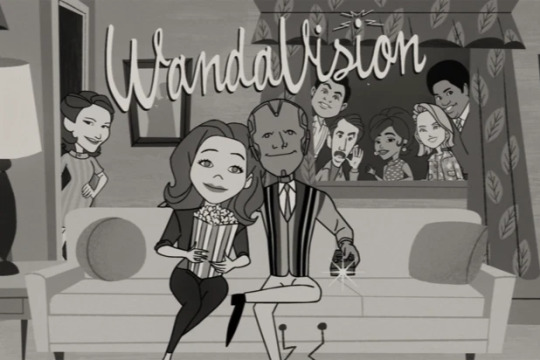
So the 60s is the era that Wandavision pulls most heavily from for it’s inspiration. So much so that one could make the argument that each of the first three episodes are all set in the 1960s. Episode one pulls from the early 60s with multiple Dick Van Dyke refences, episode two is very Bewitched inspired, and episode three is aesthetically very similar to The Brady Bunch which started in ‘69. As such it was hard to narrow down the list for this decade and I had to get creative in some ways.
1. The Andy Griffith Show (1960 - 1968)

The Andy Griffith Show gets kind of a bad rap now a days for being, supposedly, a conservative’s wet dream. People claiming it as such have apparently never actually seen the series. Oh yes, it’s very much set in white rural 60s America and will occasionally present the obliviously outdated joke, but the story of a widowed sheriff being the only sane man in a small town full of lovable lunatics, who prefers to solve his and others problems with negotiation and hair brained schemes as opposed to violence has far more in common with modern day Steven Universe than whatever genocidal fantasy fake rednecks have in their heads.
As the gif above shows Andy Griffith was very subtlety progressive for its time. Andy was a stanch pacifist, pro-gun control, treated drug addicts and prisoners with respect, and all the women he would date had careers, ect. and so on. It’s not a satire making any sort of grand political statements but the series had a moral center that was far more left than many realize.
But if it’s not a satire, then what type of comedy is it?
The Andy Griffith Show excels in what I like to call, ‘awkward comedy’. See everyone in Mayberry is far too nice to just come out and tell a character they’re making an ass of themselves, so therefore whoever is the idiot punching bag of the episode’s focus must slowly unravel as everyone looks on in helpless pity until said character realizes the folly of their ways and the townsfolk come together to make them feel happy and accepted once more. Wandavision takes this polite idyllic awkwardness and plays it up for horror instead of laughs.
2. The Dick Van Dyke Show (1961 - 1966)

The creators of Wandavision actually met with Dick Van Dyke himself to pick his brain and learn how sitcoms were made back then. Paul Bentley also took inspiration from Van Dyke in his performance of the sitcom version of Vision, while Olsen stated Mary Tylor Moore had a heavy influence on her character of Wanda. But more than just being a point of homage, The Dick Van Dyke Show was hugely influential in modernizing the family sitcom and breaking a lot of the unspoken traditions and ‘rules’ of the 50s television era. It’s also just really, really funny.
3.The Alfred Hitchcock Hour (1962 - 1965)
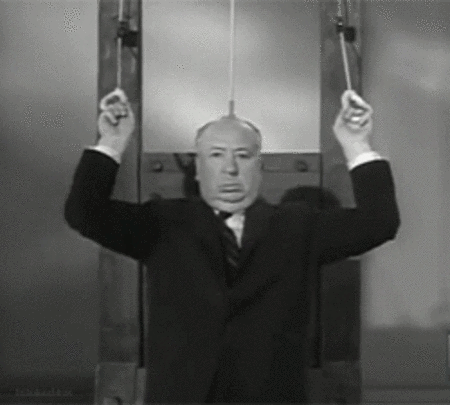
Bit of a cheat here. Alfred Hitchcock Presents actually started in 1955 as a half hour anthology show, but in ‘62 the show got a revamp and was extended into a full hour tv series. I knew I wanted The Twilight Zone to be covered in my episode one recap, but ‘The Master of Suspense’ couldn’t be forgotten. While The Twilight Zone reveled in the surreal and supernatural, Alfred Hitchcock pioneered the thriller genre and made real life seem dangerous, horrifying, and other worldly.
4. Doctor Who (1963 - present day) vs Star Trek (1966 - present day)

Just like how westerns dominated the air waves during the 50s, science fiction was the center of the cultural zeitgeist of the 60s. From Lost in Space to My Favorite Martian, space aliens and robots were everywhere. So naturally I had to name drop the two sci-fi juggernauts that still air to this today. If you thought that the rivalry between Star Wars and Star Trek was bad then you’ve never seen a chat full of Whovians and Trekkies duking it out over who is the better monster, the Borg or the Cyberman. But which one has the more influence over Wandavision?
Well Star Trek owes it’s existence to sitcoms. As with The Twilight Zone before it, Star Trek was produced by Desilu Productions and it’s co-founder and CEO, Lucille Ball, was the series biggest supporter behind the scenes, lobbying for it when it faced early cancelation. As with all things sitcomy, everything ties back to I Love Lucy in the end. However despite that little backstory, it would seem that the series has very little to do with Wandavision itself beyond being quintessentially American.
I would argue that Wandavision owes much to Doctor Who though. Arguably more so than any show mentioned in this retrospective. Time travel, alternate realities, trouble in quite suburbia, brainwashing, people coming back from the dead, ect... just about every trope you can find in Wandavision has also appeared in Doctor Who at some point. As a series that can go anywhere and do anything, Doctor Who was a pioneer of marrying genres in new and interesting ways.

5. Bewitched (1964 - 1972) and I Dream of Jeannie (1965 - 1970)

It’s hard to pick one series over another because they’re essentially the same show. A mortal man falls in love with a magical girl who upends their lives with magic filled hijinks as they try their best not to have their secret discovered by the rest of the world. And both have their fingerprints all over the DNA of Wandavision.
There’s only two core differences; Samantha and Jeannie have completely different personalities, with Sam being confident and knowledgeable and Jeannie being naïve and oblivious, along with their relationships with their respective men, Sam and Darrin being married and in love at the start of the series and Jeannie chasing after Tony in the beginning in a will they/won’t they affair, finally only getting together in the last season.
6. The Munsters (1964 - 1966) vs The Adams Family (1964 - 1966)

Fans of these two shows are forever sadden that there never was a crossover between them. Because they’d fit perfectly together. Both shows are about a surreal and macabre family living in American suburbia and disrupting the lives of their neighbors with their otherworldly hijinks. Sound familiar?
The main difference between the two shows is the way the characters viewed their placement in the world they inhabit.
The Munsters were always oblivious to the fact that didn’t fit in. They just automatically assumed everyone had the same personal tastes as them. Whenever they encountered anyone who behaved strangely around them they would write that person off as being the odd one rather than questioning themselves. As such the main cast was structured like a stereotypical sitcom family who just happened to be classic movie monsters.
The Addams were well aware that they were abnormal and they loved it! They lived life with in their own little world and didn’t care what anyone thought of them. As such the characters were far more colorful and quirky as individuals but there was little in the way of refences to other horror franchises beyond just a general love of the twisted and strange.
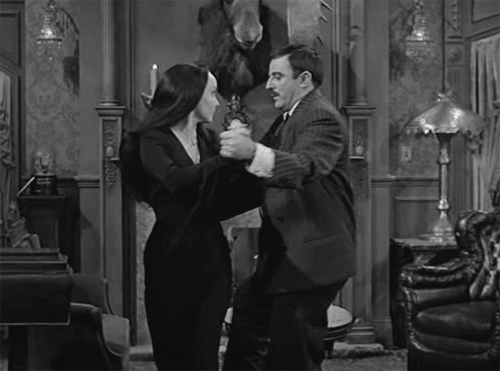
7. Green Acres (1965 - 1971) and the Rual-verse (1962 - 1971)

So the MCU is not the first franchise to bring viewers an interconnected universe to the small screen. Far from it, as sitcoms had been doing this for decades, starting with the ‘rualverse’. Beverly Hillbillies, Petticoat Junction, and Green Acres were all produced by the same company and were treated as spinoffs of each other, complete with crossovers and shared characters and sets.
Of the three, the last show, Green Acres, has the most in common with Wandavision. A well to do businessman and his lovely socialite wife settle down in small town America on a farm in order to get away from the stresses of city life, only to find new stresses in the country. Eva Gabor, herself a natural Hungarian, plays the character of Lisa as Hungarian making her one of the few non-native born Americans on tv screens during the cold war. Despite her posh nature and original protests to the move, Lisa assimilates to the rural life far easier than her husband, Oliver. Who, as the main comedic thread, can’t comprehend his new quirky neighbors’ odd and often illogical behavior.
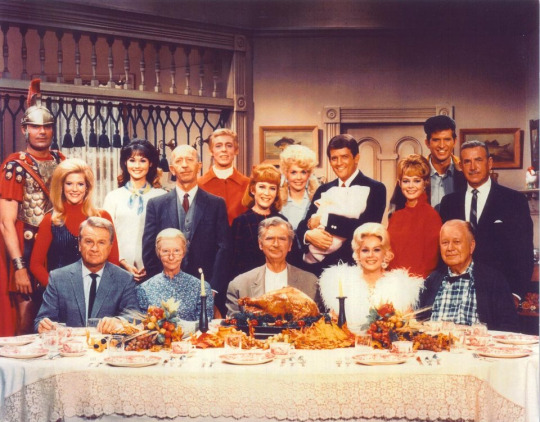
8. Hogan’s Heroes (1965 - 1971) and Get Smart (1965 - 1969)

So as comic fans have been quick to point out, it’s looking like both A.I.M. (Hydra) and Sword (Shield) will be players in the story of Wandavision. To commemorate that here’s two shows to represent those opposing sides. Although in truth, neither series has anything else in common with each other but I need to condense things down someway.
In Hydra’s corner we got Hogan’s Heroes. A show all about taking down Nazis from within.
I love, love, love, ‘robin hood’ comedies where a group of con artists try week after to week to pull one over the establishment. The Phil Silvers Show, Mchale's Navy, and Top Cat, just to name a few examples are all childhood favorites of mine. However while those shows had a lot of morally ambiguous characters, Hogan’s Heroes has very clear cut good guys and bad guys, cause the bad guys are Nazis and the show relentless makes fun of the third reich as should we all. In fact I was watching Hogan’s Heroes while waiting for the GA run off election results. Fortunately my home state decided to kick out our own brand of Nazis this year.
For Shield, we got the ultimate spy spoof, Get Smart. Starring, Inspector Gadget himself, Don Adams, as the bumbling Maxwell Smart. Get Smart, is a hilarious send up of Cold War espionage but the real selling point of the show, imho, is Max and his co-worker 99′s relationship. You can cut the sexual tension in the air with a knife all while laughing your ass off.
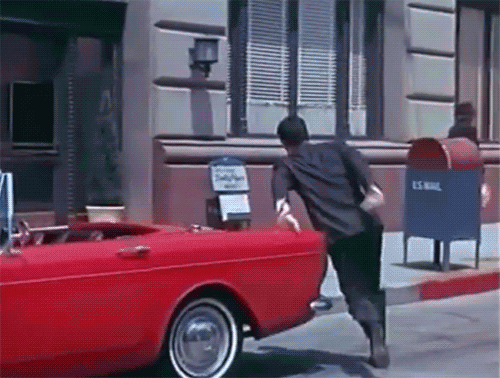
9. Batman (1966 - 1968)
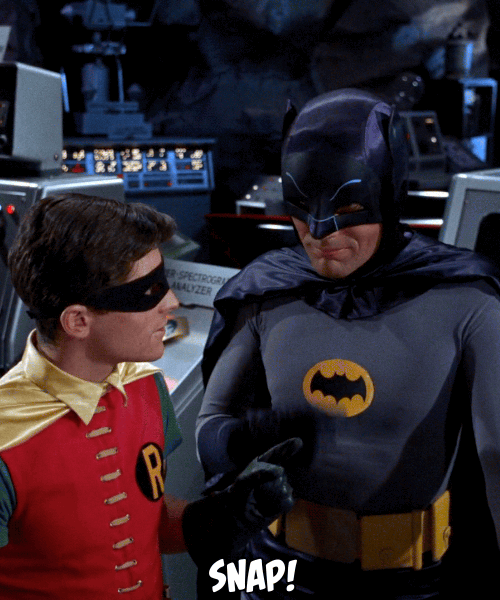
First was Superman and then came Batman. Yet while Superman was a serious action show, Batman was a straight up comedy. Showcasing that superheroes could indeed be funny.
Also shout out for Batman being the only show on this list to have an actual crossover with it’s competitor, The Green Hornet.

10. Julia (1968 - 1971)

Since episode two features the first appearances of Herb and Monica, let’s highlight the first black led sitcom since the cancelation of Amos ‘n Andy over a decade earlier. The show focuses on single mother and military nurse, Julia, as she tries to live her life without her recently decease husband, who was killed in Vietnam, as she tries to raise their six year old son on her own.
The series is cute. It’s more of a throw back to earlier family sitcoms where there’s no fantasy and life lessons are the name of the game. It’s the fact that the main character is a single black woman is what made the show so subversive and important at the time.
Runner Ups
There’s much good stuff in the 60s, so here’s some others that didn’t make the cut but I would recommend anyways.
Car 54, Where Are You? (1961 - 1963)
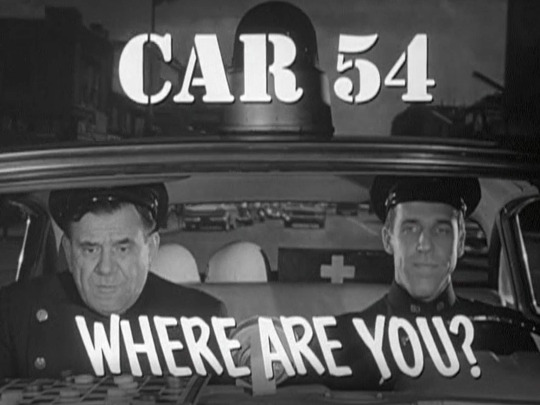
I call this the Brooklynn 99 of the 1960s. Bumbling but well meaning Officer Toody longs to do good in the world and help anyone in need, but often screws things up with his ill thought out schemes. He often drags his best friend and partner, the competent but anxiety riddled, Muldoon into his escapades.
Mr. Ed (1961 - 1966)
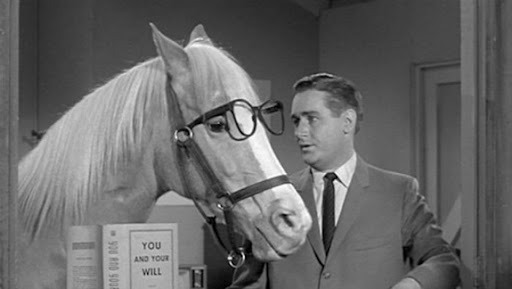
The grandfather of the sarcastic talking pet trope.
The Jetsons (1962 - 1963 and 1985 - 1987)
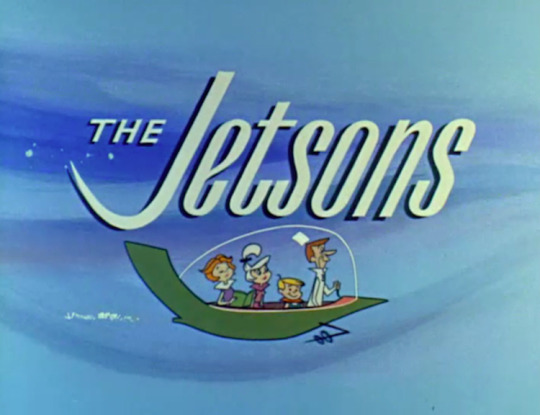
Hanna-Barbera often took popular sitcoms and just repackaged them as cartoons with a fantasy theme to them. The Jetsons has no singular show that it rips-off but is rather more a grab bag of sitcom tropes that feature, robots, computers, and flying cars.
The Outer Limits (1963 - 1965)

The Outer Limits was The Twilight Zone’s biggest competitor in terms of being a sic-fi/horror anthology series.
Gillian’s Island (1964 - 1967)
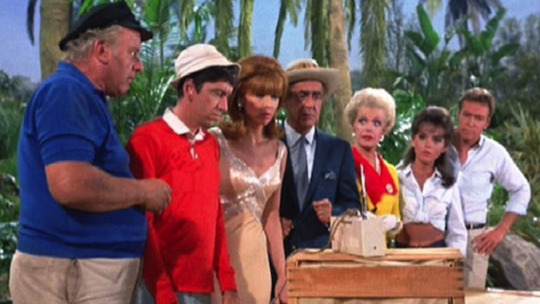
The only comparison to WandaVision I could think of was that this is a sitcom about people being trapped in one place. But by that point I was running out of room on the list. Still it’s one of the funniest shows on here.
So yeah, this took longer than expected cause there’s a lot, here. Hopefully the 70s will be easier. Which I’ll post on Friday.
113 notes
·
View notes
Text
RIP Alex Trebeck, “Save the Clock Tower” Lady, and Midnight Oil’s bassist
Over the last few days, there’s been several celebrity passings. Here is my combined remembrance of some of them:
Alex Trebek 1940-2020
Game show host Alex Trebek has died at age 80. He hosted Jeopardy! from 1984 to 2020. That game show was so iconic it was referenced in pop culture quite frequently with Trebek: Rain Main had to watch it wherever he was, Cliff Clavin was a guest in an episode of Cheers, Rosie Perez was a guest in White Men Can’t Jump, and in the episode of Seinfeld where George becomes a genius when he has to abstain from sex. SNL frequently did parodies of Jeopardy! with Will Farrell as Trebek and Trebek himself even appeared in some. Kinda cool that he had a sense of humor about himself.

Will Farrell as Trebek, Daryl Hammond as Sean Connery and Trebek on SNL
In 1995, my brother-in-law had a 3-night stand as a contestant on Jeopardy!. It was such a big deal for my family and my hometown, to see him on Jeopardy with Mr. Trebek hosting!
The link above is the obit from Variety.
Elsa Raven 1929-2020
Character actress Elsa Raven has died at age 91. Her greatest role was in Back to the Future as Clocktower Lady, who asks Marty to help “Save the Clock Tower”. She disrupts him with Jennifer, but it was integral to the plot for him to know about the clock tower in 1955 as the one way to get 1.21 gigawats to go back to the future.

Raven in BTTF
She also had roles in The Amityville Horror, Twilight Zone: The Movie, an episode of Family Ties, In the Line of Fire, the Mom and Pop Store episode of Seinfeld (she was Mom), Titanic, and many more.
The link above is the obit from Deadline.
Bones Hillman 1958-2020
Midnight Oil bassist Bones Hillman has died at 62. He joined the Australian alt-rock band in 1987 and was with them until 2020. I never got heavy into Midnight Oil, but always liked their stuff that I heard, including “Beds are Burning” (their biggest hit) and “Blue Sky Mine”.

Midnight Oil’s Peter Garrett and Bones Hillman
The link above is the obit from Spin.
#alex trebek#Jeopardy#rain man#cheers#white men can't jump#seinfeld#snl#rip#elsa raven#Back to the Future#amityville horror#twilight zone#in the line of fire#family ties#titanic#bones hillman#midnight oil#film geek#music nerd#tv
26 notes
·
View notes
Text
The Horror Influences of Thus Spoke Kishibe Rohan
https://ift.tt/2Zl6eQ9
This article contains spoilers for JoJo’s Bizarre Adventure and Thus Spoke Kishibe Rohan.
JoJo’s Bizarre Adventure is beloved by shounen anime fans for its nonstop action, absurd and over-the-top showdowns, and creative Stands (physical manifestations of one’s true self). It’s a bombastic series that defies predictions. We’re still waiting for the fifth part of the manga, Stone Ocean, to be released as an anime adaptation, and the story is still ongoing. Strangely, there’s still no confirmation that a fifth season is even coming yet.
In the meantime, however, we got something of a holdover: Thus Spoke Kishibe Rohan. An adaptation of a series of one-shot chapters from JoJo creator Hirohiko Araki, it bridges the gap between the fourth season, Diamond is Unbreakable, and the fifth season, Vento Aureo. But while it follows manga artist Kishibe Rohan and what he’s been up to between both seasons, it takes on a decidedly different slant than the vanilla anime. Thus Spoke Kishibe Rohan takes more inspiration from episodic horror anthologies, like that of The Twilight Zone or The Outer Limits. It is, by all counts, a horror series.
It’s a new direction for JoJo’s Bizarre Adventure, though not completely unexpected. The thing is, JoJo has always been riddled with disturbing, horrific, and downright chilling moments. They’ve just been couched between action-packed showdowns and bombastic character design so that the terror creeps in without you even realizing it’s there. Thus Spoke Kishibe Rohan approaches the genre in a much more straightforward manner, though, wearing its influences on its sleeve. Both series, including JoJo to a staggering degree, are inherently spine-tingling properties, even if they don’t seem so at first blush.
Creator Hirohiko Araki is a ravenous horror fan, after all, and makes no secret of his passion for the genre. In his book, Hirohiko Araki’s Bizarre Horror Movie Analysis, he cites some of his top 20 favorite films as Misery, Alien, and The Texas Chainsaw Massacre. The work itself is divided into several parts, each exploring a different branch of chilling media, such as “Bizarre Murderers,” “Animal Horror,” or “Sci-Fi Horror.” It wouldn’t be out of the realm of possibility to think that, despite Thus Spoke Kishibe Rohan originally being meant to be unrelated to JoJo, Araki created it to satisfy his love for the macabre.
The episode “Mutsu-kabe Hill” follows a woman named Naoko Osato, who belongs to a well-to-do family. She’s living in a house that belongs to said family along with boyfriend Gunpei Kamafusa. But she can’t be with Gunpei, as she’s already betrothed to a man her father has chosen. Plus, Gunpei is a family gardener, a profession her father won’t abide. The two end up arguing, and Nao tries to pay off Gunpei to get him to leave, as she knows her father and fiancé are on their way to the home. But tensions escalate as the two become violent.
Nao pushes him into a set of golf clubs and Gunpei dies instantly. He’s bleeding, and while Nao struggles to figure out what to do with his body, her father and fiancé are approaching her home. No matter what she does, she can’t get Gunpei’s corpse to stop bleeding. In the end, she lives with this bizarre phenomenon, telling no one about her plight, and doting on Gunpei’s corpse, disposing of the blood he continues to generate for the rest of her life.
Several comparisons can be drawn from this episode to Edgar Allan Poe’s “The Tell-Tale Heart,” in which the narrator commits a murder, dismembers a body, and hides it beneath some floorboards. Despite having seemingly gotten away with the perfect crime, the narrator is driven insane by the sound of his victim’s heartbeat. He ends up confessing to the authorities as he believes they can hear it, too. It’s the story of an unreliable narrator whose sanity is slipping.
Though the narrator in that story ended up confessing to ease his suffering, Nao chose to live with the consequences of her crime, succumbing to a monster that lives off of people’s affection. The stories are quite similar in tone, though with very different outcomes.
In “At a Confessional,” Rohan recounts a story of how he met a man who confided in him while in an Italian confessional. The man spoke of a beggar to whom he refused food and instead forced to work until he died. The beggar returned as a ghost, swearing revenge on the man who wronged him, promising he’d return on the happiest day of the man’s life. Return he does, as the man has enjoyed riches beyond belief, a beautiful marriage, and the birth of a daughter.
The beggar appears in the form of an apparition in the man’s daughter’s tongue. He forces the man to toss pieces of popcorn his daughter was eating into the air and catch them with his mouth three times in a row in an absurd challenge. If the man succeeds, his life will be spared. If not, he’s beheaded instantly.
Read more
TV
Anime For Beginners: Best Genres and Series to Watch
By Daniel Kurland
TV
How to Watch Anime Online: The Best Legal Anime Streaming Options
By Daniel Kurland
This tale immediately recalls Stephen King’s Thinner, a similar story about a man who’s committed several wrongs, cursed the father of someone he’s murdered — this time, because he runs over a woman while driving and engaged in a sexual act with his wife. The curse finds the man, who is obese, becoming thinner and thinner at an uncontrollable rate.
Eventually, there are options available to the man, who pleads for a resolution. He’s informed by the same person who cursed him that he can eat a strawberry pie with his blood in it and die, or give it to someone else for him to be spared. It’s just as gruesome as forcing the rich victim in Kishibe Rohan to munch popcorn or die.
In JoJo’s Bizarre Adventure, the scares seem to come directly from a series of inspirations for Araki instead of new stories based on the media he’s obviously consumed.
The first JoJo arc, Phantom Blood, sets the stage by introducing a swath of Gothic horror elements. It introduces the eventual vampiric rise of DIO in a Victorian society, which directly references classic novels like Dracula and Frankenstein. There’s even a serial killer named Jack the Ripper, who faces off against Jonathan and his allies, pulled straight out of history — a perpetrator of grisly murders who ends up transformed into a zombie. The undead are also a major component of Phantom Blood, likely due in part to Araki’s love for classic zombie cinema.
In the arc Stardust Crusaders, Jean-Paul Polnareff finds himself de-aged by a Stand user named Alessi. A young woman named Malèna nurses him back to health, up until Alessi uses his Stand, Sethan, unceremoniously de-ages her to that of a fetus outside of the womb. A few of Araki’s favorite horror movies of all time, including Basket Case, center on body horror, which doesn’t make this narrative decision surprising. But for those reaching that point in the story for the first time, it’s chilling in a way that even some of the most nightmarish films can’t even touch.
While the visual of a fetus itself isn’t as offensive as some gnarled, disfigured victim, its implications are disturbing, to say the least. A fetus outside of a mother’s womb will eventually succumb to a slow death, especially one of Malèna’s apparent age. That makes Polnareff’s eventual victory over Alessi and his Stand so bittersweet.
The entirety of the fourth arc, Diamond is Unbreakable, plays out like a classic slasher flick with the introduction of Yoshikage Kira, a man with a powerful obsession with hands to the point of fetishism. He murders women with “beautiful hands,” then keeps the hands as his “girlfriends.” It wouldn’t be a stretch to compare Kira to classic killers like Psycho‘s Norman Bates or The Silence of the Lambs’ Hannibal Lecter, as Kira is believable and charming when he isn’t committing grisly murders.
Most of JoJo’s Stands are horrific on their own, and even though their story arcs enhance their terrifying power, there’s a fair amount of fridge horror to be found in these beings. The Freddy Krueger-like Death 13 can kill you in a nightmarish dream world while you sleep. Metallica (yes, named after the heavy metal band) forces you to cough up razor blades or have scissors burst from your chest.
Another Stand, Green Day, can secrete a deadly mold that will rot and destroy the flesh of anything it touches in an instant. Lastly, Rohan Kishibe himself has a fairly disconcerting Stand: Heaven’s Door. It allows him to literally read someone like a book, then erase parts of their being, or add in what he pleases, like the ability to learn a new language as his pal Koichi asks in Thus Spoke Kishibe Rohan.
It’s easy to see how Araki has masterfully melded horror into every space when it comes to both JoJo as well as Kishibe Rohan. With that in mind, it’s strange that the former has been relegated only to a series of one-shots when it shows so much potential as its own project, in which Araki gets to stretch his Rod Serling-esque legs or impart some very Argento-like stylings into his works. For now, we can appreciate what’s there — and continue finding parallels to additional well-loved classics in the genre.
cnx.cmd.push(function() { cnx({ playerId: "106e33c0-3911-473c-b599-b1426db57530", }).render("0270c398a82f44f49c23c16122516796"); });
Thus Spoke Kishibe Rohan is available to stream on Netflix now.
The post The Horror Influences of Thus Spoke Kishibe Rohan appeared first on Den of Geek.
from Den of Geek https://ift.tt/3bOxa0C
9 notes
·
View notes
Text
BLOGTOBER 10/30-10/31 (IT AIN’T OVER YET!): DISCONNECTED (1984) + PERSONAL SHOPPER
One night on a double date at a local night club, sweet, shy Alicia (Frances Raines) tries to tell the foursome about a strange experience she has had that day: She let an old man into her apartment to use her telephone, but he mysteriously vanished before she could let him back out. Her friends are not interested. Her boyfriend Mark (director Gorman Bechard), a smug radio DJ, dismisses her story as some sort of misunderstanding, and her vivacious twin Barbara Ann (Raines) cuts her off entirely by flirting openly with Mark, insinuating that she was with him that afternoon. This is the last straw in what appears to be an ongoing problem for Alicia. Outside in Mark's car, she refuses to accept his denial of sleeping with Barbara Ann, beginning an agonizing breakup process that drags out for days. Even at her job, Alicia can't seem to establish any personal boundaries; an awkward young stranger called Franklin (Mark Walker) visits during her shift at the video store, and reveals that he doesn't even own a tape player--he just found out who she was and where she worked from other club patrons the previous evening. Alicia rebuffs his unseemly advances at first, but with the insulting drama still festering between Mark and her manipulative sister, loneliness sets in. She could use some company to help insulate her anyway, since their town is plagued by a killer of young women...and stranger still, Alicia's telephone has taken on a mind of its own, broadcasting otherworldly sounds into her apartment, slowly driving her mad. She has a difficult decision to make about who or what she can trust, but it may be that there is no correct choice.
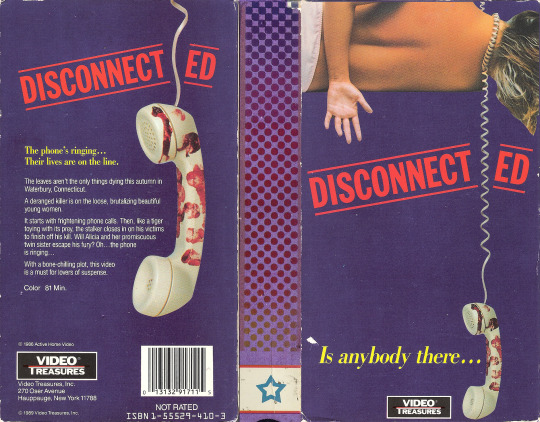
Gorman Bechard's atmospheric 1984 oddity DISCONNECTED follows in the footsteps of CARNIVAL OF LOST SOULS, joining a subset of subdued psychological thrillers about women alone. In Herk Harvey's 1962 classic, Candace Hilligoss plays Mary Henry, a withdrawn young woman who moves far from home after a traumatic accident. Where she hoped to find peace, she is stalked by a spectral male figure, and receives no help from the locals, who are all suspicious or covetous of her. The boundary between the living and the dead begins to dissolve, mirroring her increasingly ambivalent relationships with other human beings. Mary is torn between her longing for solitude and her fear of impending doom, having to choose between an intrusive suitor, and being left alone with her cadaverous stalker. Mary's unforgettable journey through her desolate surroundings, her isolation interrupted only by enemies both open and hidden, describes an experience that many female viewers have found familiar. Social life portends various threats--judgmental elders who pick at your morals and appearance, jealous females, emotionally and physically violent males--while solitude offers obliterating blankness, like a desert whose expansive monotony renders meaningless the defining lines of past, future, and self. In modern times, this distinctly female experience is complicated by the evolution of personal communication media. The telephone in particular--which has been historically and rather demeaningly associated with girls--is both a channel through which to reach out and touch someone, and an opening through which unwanted attention can insinuate itself into our lives. Two years ago, I saw DISCONNECTED--a loopy microbudget slasher movie from Waterbury, Connecticut--and one of my first thoughts was that it was somehow just like PERSONAL SHOPPER, Olivier Assayas' heady cyberpunk-flavored thriller from 2016, in which a servant to the stars receives threatening text messages from someone who may or may not be among the living. I've been trying to put the two together in writing ever since.

In PERSONAL SHOPPER, Kristen Stewart plays introverted American Maureen, the virtual slave of supermodel Kyra (Nora von Waldstatten). Maureen is a stranger in a strange land, travelling relentlessly around Europe to procure garments and jewels for her boss in Paris, and on her personal time, conducting a psychic survey of her late brother Lewis's mansion. Twin mediums Maureen and Lewis promised one another that whoever died first would send the other a sign from across the divide; Maureen has been waiting since his untimely heart attack for him to hold up his end of the bargain. So far she has only witnessed some scattered poltergeitic activity, along with the manifestation of a ferocious, unknown female specter, but the clock is ticking, as the manse is mid-sale to Lewis’ friends. Furthermore, it is her employment with the tyrannical Kyra that allows her to stay in Paris and wait for a sign from Lewis, so Maureen’s freedom also is dependent on the resolution of this situation. When she meets Kyra's arrogant lover Ingo (Lars Eidinger), he inappropriately insists that he can get her a better job elsewhere, but she explains that she can't change her life until she has closure with her brother. Shortly after this unpleasant encounter, Maureen begins to receive intrusive texts from an unknown caller. Due to her unusual relationship to the dead, she can't be sure if her new stalker is a part of her world, or not.

PERSONAL SHOPPER has very much the flavor of William Gibson’s speculative fiction novel Pattern Recognition, in "cool hunter” Cayce Pollard has the extra-sensory ability to detect what new designs will become popular next. Cayce’s special power manifests as a crippling allergy, and so she tries to remain in timeless, fashion-neutral clothes and settings whenever possible. Psychic Maureen feels a similar kind of existential ambivalence toward the super luxe materials she excels at curating for her client.
Maureen spends much of her screen time alone. Most of her personal contacts are with salespeople; she virtually never sees Kyra in person, and her boyfriend Gary (Ty Olwin) lives in Oman, which may as well be another world. Her chief relationship is to her dead brother, who is literally in another world, and who responds with frustrating ambiguity to her pleas for a clear message, even as his mansion rumbles with unexplainable activity. This void of connection seems somehow related to Maureen's tenuous sense of personal identity. With no close connections, she cannot accurately detect her own contours. Maureen is totally sublimated into Kyra's life, simply an extremity that grasps for whatever Kyra needs. At the same time, she is subject to Lewis's will, unable to make any moves--even to protect herself--until her late brother deigns to give her peace. Maureen's identity is entirely determined by other people, including the mystery caller who lures her into a confessional conversation with him. Although this third figure is the most predatory of them all, he is also the one who teases out the threads of Maureen's fraying individuality. When she admits to trying on Kyra's clothing, just because she's not allowed to, he entices her to stay in Kyra's bed while she's away, further feeling out her own limits. This is the only way Maureen can establish a self that is independent of the context of others: by violating the taboos established by those others. The rule-breaking method of finding oneself is an integral part of the human condition, as explained by media theorist Marshall McLuhan in a discussion of the self in the age of social media:
"Yes, all forms of violence are quests for identity. When you live out on the frontier, you have no identity. You are a nobody. Therefore, you get very tough. You have to prove that you are somebody. So you become very violent. Identity is always accompanied by violence. This seems paradoxical to you? Ordinary people find the need for violence as they lose their identities. It is only the threat to people’s identity that makes them violent. Terrorists, hijackers - these are people minus identity. They are determined to make it somehow, to get coverage, to get noticed."
By breaking Kyra's rules just on principle, Maureen moves toward self-actualization. Unfortunately, this comes at a cost, as the mystery caller who encourages this process wants to possess her just as much as Kyra and Lewis already do.
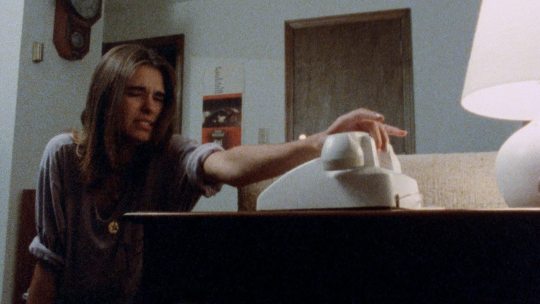
Maureen's phone has become a ouija board-like portal to another plane, through which alien forces can cross over and affect our fate. In DISCONNECTED, Alicia suffers from a similar problem. Alicia's social isolation, and the increasingly meaningless division between life and death for her, is underlined by the fact that she lives on the edge of a cemetery. Her phone is her connection to the world--to the ambiguous Franklin, to her sister who she can neither accept nor reject, to Mark who she can't quite leave behind. She can't get rid of this device, even when it starts to ring almost constantly, with a horrifying, vaguely vocal-sounding barrage of electronic noise on the other end. As in PERSONAL SHOPPER, Alicia is largely seen alone, pacing in her apartment, wandering teary-eyed in the depopulated streets of Waterbury, and eyeing her phone with nervous anticipation. She finds herself living out an appalling version of the classic Twilight Zone episode "Night Call," in which Elva, an old widow longing for her late husband, is harassed by increasingly disturbing phone calls from beyond the grave. Like Elva and Maureen, Alicia also suffers from the conflation of companionship and otherworldly threat: Just as she doesn't understand the source of the distorted calls, she also doesn't know that Franklin--her potential savior from this dark chapter of her life--is a serial murderer, planning to have her for his next victim. When Barbara Ann makes a move on him, perpetuating the cycle of sororal abuse that started with Mark, Franklin kills her instead, removing one of Alicia’s few contacts with the rest of humanity.
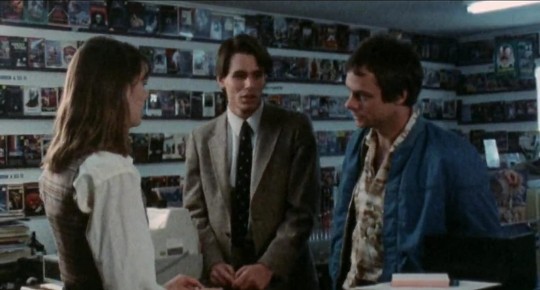
BTW, even though Alicia eventually takes a liking to Franklin (center), her experience at the video store--here, trapped between an aggressive suitor and a similarly aggressive porn consumer--forms the most realistic portrait of retail hell for girls that I have ever seen in my life. When Franklin first arrives, announcing that a) the movies there aren’t good enough for his refined tastes, b) he doesn’t even own a video player, and c) he’s only there because he’s stalked Alicia from her local watering hole, his intensely condescending attitude and presupposing come-ons gave me a hardcore PTSD reaction from the many years I spent behind the counter of a comic book store. Yuck.
While Alicia doesn't understand what is happening until it's almost too late, Maureen's situation escalates horrifically when her latest jewelry delivery brings her face to face with Kyra's mutilated corpse. As she reels from this gruesome sight, she also detects a malevolent presence vibrating deeper in the apartment that sends her fleeing in terror. When she goes to the police, her mystery caller suddenly becomes more sinister, demanding to know whether she has told the cops about him. In short order, the caller tries to blackmail her into meeting him in a hotel room, but this climactic union is circumvented by the police: It was Ingo guiding Maureen's journey of self-discovery, and Ingo who killed Kyra. The revelation is enormously painful, not because Ingo is so important, but because he managed to victimize Maureen using her most uniquely personal characteristic: her relationship to the supernatural. She believed that something personally significant was happening to her, according to her special understanding of the world, but she was merely being preyed upon by a violent narcissist. Her profound belief in her own paranormal sensitivity--the one thing she is sure of, that distinguishes her from others--is what made her vulnerable to the insistent texts begin with: She wondered if it was Lewis texting her. Ingo exploits Maureen's convictions about herself to perpetrate a deadly fraud, leaving her violated and humiliated. Even though we witness the presence of an unseen entity (Lewis? Kyra?) moving through the hotel, perhaps influencing Ingo's capture, Maureen is left to suffer for being gullible and vulnerable, to mourn her own privacy.

Of course, Maureen's journey is not over yet, and Alicia receives a similar shock with a full half an hour to go in DISCONNECTED. She is rescued by her own screams on her last date with Franklin, as the sounds of their skirmish draw the police to his apartment where they summarily execute Alicia's would-be killer. Now she is left with almost no worldly connections at all--save for the malign presence that keeps calling her phone, blasting her with waves of mind-melting noise. To make matters worse, there seems to be a new victim in the rash of murders previously tied to the late Franklin. Alicia plunges into a spiral of nihilistic despair, in which her closest relationship is with her conniving ex--mediated by the phone, and by his radio show where he dedicates songs to her--second only to the mystery caller who dials her number several times an hour. Craving a human connection, Alicia eventually relents and lets Mark take her out again, and things seem to be on the upswing...until Alicia returns home to find that something worse than electronic fuzz has entered her home, to put an end to her misery. We don't share her final vision, but we do see the mysterious old man (William Roberts) from the beginning of the movie, the fellow she let in to use her telephone, strolling into the cemetery--presumably, from whence he came.

Like Alicia in the aftermath of Franklin’s death, Maureen also has to find a new way to survive after an episode of shocking violence. For Maureen, the only way through is out. As she prepares to leave Lewis' mansion, she encounters his widow's new beau, Erwin (Anders Danielsen Lie). This encounter crystalizes the movie's themes regarding time. Early in PERSONAL SHOPPER, Maureen is turned on to the visionary paintings of Hilma af Klint, a 19th century painter who claimed that she made her art at the behest of ghosts. She mandated that her work only be revealed to the public after her death, creating a communication channel between the deep past and the distant future. Maureen argues with her doctor about the future; he insists that her brother's heart attack was purely anomalous, but Maureen sees no reason why the same thing couldn't happen to her. She sees no future for herself, and is chained to the past by the ghost of her brother, who withholds the spiritual message that would allow her to move on. Lewis thought a lot about the future, Maureen remarks cynically to her doctor, despite the fact that he was ultimately deprived of one. Later, Lewis' widow Lara (Sigrid Bouaziz) explains that she feels the future is in flux and unknowable--a desirable quality, in her book--and so she is moving on to be with Erwin. So, when Maureen encounters Erwin on her final night in Paris, they have a pointed conversation about the shackles of the past and the fossilizing force of guilt on one's life. Lewis's ghost cruelly teases Maureen at the end of the scene, demanding attention but refusing to reveal himself. With nothing to show for her devotion to her brother, she flees Europe.

In both DISCONNECTED and PERSONAL SHOPPER, the archetype of the twins is used to describe opposing states of being, and the threat of having one’s life usurped by another version of oneself. Alicia's sister Barbara Ann is lively, sensuous, and self-serving: everything that Alicia is unable to be, and the consumer of everything Alicia wants for herself. With her unrealistic desires for honesty and compassion, Alicia is the more death-oriented twin: cut off from social life, deprived of pleasure by more ambitious people, and vulnerable to parasitic attacks from both sides of the mortal veil. Alicia even dreams of Barbara Ann murdering her, and literally taking her place in bed with Mark. Maureen's twin Lewis is described by his survivors as passionate and living on the strength of his own convictions; Although Maureen still lives, she is inert, somehow chained to him, slavishly waiting for him to grant her release, though he is content to torment and manipulate her. The protagonists of both films are subjugated to these duplicates who refuse to stay on their side.

Maureen flees to Oman to reunite with her boyfriend Gary--heretofore only a pixelated image in a video chat who begs her to give up her commitment to the kingdom of death, insisting that only the material world exists and is waiting to embrace her. Of course, when Maureen arrives in Gary's placid and spartan world at what may as well be the end of the universe, her problems have followed her. We will never see Gary in the flesh; he has left a written note of welcome for Maureen, which she reads just as she detects a supernatural presence in his dwelling. Hoping against hope that Lewis is finally reaching out to her, she asks out loud: “Is it you? Are you at peace? Are you not at peace? ...Or is it just me?” And, hauntingly, she hears a ghostly knock in the affirmative for every question.
The ambiguity of this ending has troubled some viewers, although multiple interpretations present themselves which are not mutually exclusive. In the most literal sense, Maureen can be seen as a terminally frustrated Carrie White-like figure who causes material disturbances with the power of her own inner turmoil. The paranormal phenomena she perceives are, indeed, “just her”. On a more metaphorical level, we can see that Maureen is haunted by her own grief, over her brother, and also over her failure to forge a life of her own. In her mind, her brother was a superior life force to which she remains subservient; she identified herself entirely as a receiver for his message, and without his active participation in her life, she loses all sense of purpose. She scrutinizes ghostly disturbances and the spiritual conduit of the telephone to inform her place in the world. Without an internal, independent reason for being, people like herself, and like Alicia, are forever haunted.

#blogtober#2020#disconnected#disconnected 1984#personal shopper#olivier assayas#frances raines#kristen stewart#lars eidinger#sigrid bouaziz#mark walker#anders danielsen lie#ty olwin#horror#supernatural#viral media#phone horror#slasher#mystery#ghost#haunted house#gorman bechard
18 notes
·
View notes
Text
A Little Response to Rhavewellyarnbag's latest Review of The Terror's "Horrible from Supper" (the italics are me)
Being another look at The Terror, episode 01x07, “Horrible From Supper”.
But first, the characters in The Terror to whom I own an apology for the things I said last night when I was drunk, in ascending order of how vile it was:
Francis. Yes, what I said was true, but I should not have said it.
Goodsir, on general principle, because he is a nice man, and doesn’t deserve to have the likes of me talking about him that way.
Author’s note: Only daily do I apologize to Harry Goodsir (fictional) for the things I say about him, and to Harry Goodsir (nonfictional) for the things I say about a fictionalized version of him. I like to think that the former would forgive me, but I think that the latter might not. I painted him from the few photos made of him; he has a delightfully reproachful look. Resting bitch face, even.
In the 1845 photos, his eyebrows come together in a way which could be interpreted as judgmental. But, when we think of the trials of sitting for a daguerreotype at that time (not nearly as jolly and pain-free as depicted in “The Ladder” –forgetting about the subsequent Tuunbaq attack) Goodsir’s reproachful look might merely result from the tedium of having his picture taken (or that fatal tooth was beginning to hurt).
Tozer. Though, again, I meant it, and, like, look, I defy you tell me that he doesn’t look absolutely stunning when he’s afraid for his life in “Terror Camp Clear”.
“The Terror” certainly broadens the parameters of handsome-ness. Tozer, while listening to Morfin singing “The Silver Swan”, is more attractive than, than, than the Moon! Or the Pyramids! He’s supernatural.
The ship before it weighs anchor, before it, in some fundamental way, becomes a ship. Not yet having fulfilled its function, it is more like a theatrical set. The notion of limbo is a fitting one: the men descending the ladder, coming from the bright, noisy world above, could be entering the afterlife.
Who’s the cat who does the words about utter existentialism? Rod Serling, was that his name? Did everyone see his episode of “The Twilight Zone” about the toys in the Salvation Army barrel? Yikes.
Nothing is working as it should, logic is suspended, and the topsy-turvy world of the carnival will become real.
The movie “Topsy-Turvy” is a great favorite of la famille Sunbeam. Even so, there are useful parallels between that film and “The Terror”: class clashes, pretense and pageantry, and mainly ripping away the fine lace mask of the Victorian era. The attitude of the servants in both shows is strikingly craven.
“Any tips, sir, for a first-timer?”
In the super-heated world of fandom, “any tips for a first-timer” sounds like the sort of pick-up line EC would use on the true Cornelius.
Poor Morfin.
Morfin is “The Terror’s” equivalent of the Victorian Little Nell. Headaches, bad teeth, song-forgetter, probably a once-in-a-lifetime sodomite but nevertheless flogged for it. When he and Tozer go out on that exploratory mission, he falls flat down and Tozer says something like “Don’t volunteer if you don’t have the bottom for it.” (More heat for the fandom). And he gets to be the first to see the severed heads. (Who thought Tozer and Morfin would make a good team for this task? Did they draw names?)
“Gently with that one, please.” It’s a little bit insensitive of Goodsir to express concern for his luggage before he does, Morfin, after Morfin’s just collapsed from pain, only looking like the living dead. That trunk, though, is Jacko’s tomb.
Harvey, your theory about Goodsir’s, ah, class-related selfishness is confirmed here.
“Are these our choices, Cornelius, or are they being made for us?” Gibson seems to falter, which is interesting. His idea to separate from the larger group doesn’t seem to be his own, which suggests that Hickey understood that it couldn’t be seen to have come from him.
Gibson looks like death warmed over, but Hickey is just as perky as ever.
Gibson seems to get on-and-off injections of great intelligence, but his death-warmed-over look is consistent through the series.
Hickey is also under-dressed, not even wearing a hat.
This is perhaps a very English-major thing to say, but there is a suggestion of a climate change (or a massive change in consciousness) occurring after Carnivale, as if the trauma of the fire left living dead who can no longer feel the cold, or, having felt so much fire, the survivors have had the idea of cold burnt out of them.
He does sometimes dress more appropriately, as in “A Mercy” when he was helping Hartnell transport supplies for the carnival. Suggesting that, in this scene, Hickey means to maximize his attractions. The obvious beneficiary is Gibson, but I think Hickey sees some value in displaying himself for Tozer, the one Hickey is really after, and has been since at least “Punished As A Boy”.
A sexy thought; how much nudity the men would crave. When Hickey is flogged, he is completely exposed to the men present, and I think the sexuality of his having his pants pulled down really hits the sailors hard. Francis alone looks like he’s going to climb out of his skin with the ferocity of his feelings (I won’t say desire, but that’s what I mean). Was it you, Harvey, or someone else who discussed how strong the thirst for touch must be among the Franklin Expedition? I imagine the thirst to see bodies is just as powerful.
Then, I was immediately resurrected by the peek at Collins’ suspenders. He is... built like a cement outdoor commode. There is a lot of Collins to love.
The suspenders become iconic. Collins is one very alluring sailor, even in his bulky sea-diving outfit with that great furry head sticking out. Yet his sexuality seems neutered, compared to the other significant sailors (Still, if Hollywood decided to make a chubby “Wuthering Heights”, Collins would make the perfect pudgy Heathcliff.)
Author’s note: I don’t think Francis thinks very much of Goodsir, and the feeling is mutual. Goodsir has to obey Francis, but it’s duty without devotion, without deference, Goodsir having seen very little that would indicate to him that Francis has reformed himself. Francis may have stopped drinking, but he’s up to his old tricks, dismissive unless he wants something, ingratiating when he does. This is the way that Francis behaved toward Hickey, which gives an interesting contrast between Goodsir and Hickey: once Goodsir understands Francis’ motives, he’s no longer taken in; Hickey must understand that Francis was only drunk and trying to get into Hickey’s pants, but Hickey continues to try to make Francis like him.
Francis might resent Goodsir’s place in society, so settled and unique, while Francis himself has to maneuver around Sir John and James and all the rest. But Hickey he can control. (In a way, it’s a shame that Irving, the stupid old king of coitus interruptus, has to bust in again. It would be in vain, and yet interesting, to consider what might have happened if that seduction had been consummated. Think of the bickering harem Crozier could assemble: Hickey and Jopson and Gibson and then Irving, etc etc. (But this speculation, that a captain would handpick a seraglio of sailors, is ruined by the knowledge that, despite all the porn stories and movies, there is no one a teacher would want less to seduce than her students.)
James has to move his little pick ax from one hand to the other to reach out to Francis, suggesting that, emotion aside, he made a conscious decision (his bones not yet reduced to broken glass) to grab Francis’ jacket, right over his heart, no less, and jostle Francis in a friendly manner.
This moment is comparable, to those who might be interested, to Star Trek: The Original Series’s “Amok Time” when Spock grabs Kirk by the arms. Quite the pensee could be written comparing Kirk-Crozier (the fair-haired captains) and Spock-Fitzjames, the haughty eyebrow-waggling second. The latter’s reserve is melted, melted utterly by his realization of how much he loves his Captain.
Author’s note: I am into Edward, but conditionally: I like him in that coat that makes him look substantial. Matthew McNulty is lovely, but he’s far thinner than I thought he was, which came as a bit of a shock.
His shortness is also quite astonishing.
I can’t imagine Levesconte being involved.
Levesconte is too busy lying on his little officer’s cot, reminiscing about the time he said “benjo” and everybody cheered.
“There was a fourth man.”
I know you are referring to the raid on Silna in “Punished as a Boy”, but these words put one in mind of T.S. Eliot’s notes to the “Fire Sermon” in his “Wasteland”: “it was related that the party of [Anarctic] explorers, at the extremity of their strength, had the constant delusion that there was one more member than could actually be counted”. Ah, the hypnotic potency of the top of the world.
Did Edward just grab Irving’s knee? Judging by Irving’s expression, yes, I think he did. I think he leaves his hand there for the rest of the meeting.
Actually, no, he does not, but he appears to again bring it down to the general vicinity of Irving’s lower body.
I have run this scene over again and again and again (like the Zapruder film), and I think Edward does make an aggressively intimate gesture: “left and to the back, left and to the back.” Irving does not seem displeased.
Hickey begins to assume what he imagines as Tuunbaq’s character. Having already, it’s implied, eaten part of Heather’s brain . . .
It is more probable that Hickey was just tapping at Heather’s brain, mainly because a brain IS not like a pudding; a pudding can be nibbled on without anyone noticing. But if someone nicks a part of a cathedral, which is a self-contained entity, it would be noticed by, at least, Nurse Tozer. Still Hickey might have tasted the cerebrospinal fluid, just for the Hickey of it.
When first aboard Terror, Hickey appears to be sizing up his new environment, but he also looks relieved, hopeful. It’s implied that he had a lucky escape from England, which had gotten too hot for him, but I think that he really believed that he was making a fresh start. Taking another man’s name was practical, perhaps a necessary evil, but I think that E.C. just didn’t want to be E.C. anymore.
I admire the symmetry of Hickey throwing a Neptune-sized bag down by Hodgson, thus startling him far more than one think a tough lieutenant would be startled.
Author’s note: . . Silna doesn’t fall into Goodsir’s arms, because there’s no reason why she would; she might like him, but he’s merely the least untrustworthy of a group of untrustworthy men who, by the end of the series, have not just made her home almost uninhabitable, but killed her father and her friends. Her discovery of Goodsir's body, the state it’s left in, confirms it: if this is what the British do to each other, she was lucky to get away when she did.
Hear hear!
By the way, if one is in the mood, another pensee could also be written about the real daguerreotypes of the Franklin expedition. I am particularly amused by Gore and Fairholme. Gore hates Lady Jane and this stupid thing she’s making him do. just so Sir John can be further exalted. Fairholme picks up the vibe and poses just like Gore, only he has to borrow the affable Fitzjames’ jacket.
I think we’ve all been there.
17 notes
·
View notes
Text
Carnival of Souls: The Story
At first glance, the story of Carnival of Souls doesn’t seem like anything special. In fact, if anything, it seems a little….off. Almost empty, at times. Unlike many of the other movies we’ve looked at in the past months, in Carnival of Souls, there is only one storyline, focused on exactly one character, and even that seems rather loose at times, unfocused. The entire movie has a very meandering feel to it, despite its single, if vague, plot.
I’ll show you what I mean. Let’s take a look at the story of Carnival of Souls. (Spoilers below!)
The story opens on three women in a car, driving along the road. A car with a few men in it pulls up alongside, challenging them to a drag race. The women agree, and the cars take off. Before either group can be declared a winner, the race comes to an abrupt end when the car full of women goes out of control, off a bridge into a river.
The police dredge the river for hours, unable to find the car (or the women) in the fast-moving river. All hope seems lost, until one of the women, Mary Henry, clambers up onto the bank, muddy and shaken, but seemingly unhurt, with no memory of how she managed to survive.

Mary, the lone survivor of the accident, seems to move on, taking a job as a church organist in Salt Lake City, Utah. Before she leaves, she returns to an organ factory in town, beginning an impromptu concert for one of the workers there. Impressed, the worker suggests that she come back and play again for them sometime. Mary stands and begins to leave, stating coldly that she has no intention of ever coming back.
Already the opening to this film is really strange. The car chase is portrayed as more eerie than exciting, and Mary doesn’t seem to have a lot of presence as a character. She is cold, emotionless, likely traumatized as a result of the accident. The entire beginning doesn’t seem horrific, just…odd. The camera usage only emphasizes the isolation and outsider nature of Mary’s character, made even clearer later in the film.
Mary sets off on her trip, and while driving through the desert, her radio seems to malfunction, only picking up organ music. Bothered by this, she is further unsettled by visions of a pale, ghoulish figure who appears in her car window. As abruptly as he came, the figure disappears, only to materialize again in the road in front of her. Panicked, Mary drives off the road, collecting herself as the figure (only referred to as The Man) vanishes again, without a trace.

Resuming her journey, Mary finds herself drawn to a strange, abandoned pavilion on the outskirts of the town. Curious, she stops at a gas station, asking the attendant for information about it. The attendant tells her that the structures used to be a bathhouse, then a dance hall, and finally, a carnival, before it closed.
Shaken, but still determined to get her job, Mary rents a room at a residence owned by an older woman named Mrs. Thomas, and meets the only other tenant, a distasteful character named John who is determined to become better acquainted with her. Her first day in the new city passes mostly uneventfully. She travels to the church she is taking a job at, meets the minister and practices on the organ. The minister offers her a ride, and she agrees, asking him to take her to see the abandoned carnival on the outskirts of town. He agrees, and he drives her to the gated entrance.

Mary wishes to go in, but is stopped by the minister, who explains that nobody is allowed to enter. Subdued, but not satisfied, Mary returns to town. While in the boarding house, she believes that she again sees The Man, and flees to her room in a fit of hysterics. The landlady, Mrs. Thomas, comes up to offer her a dinner, assuring Mary that she must have imagined the figure. Despite her attempts to comfort Mary, Mrs. Thompson clearly believes Mary is disturbed, and leaves Mary alone. Mary passes the night dreaming of the pavilion.
The next morning, the tenant John turns up at her door, offering to share a coffee. The two talk for a few moments, and Mary explains that she views her job at the church as just that, a job. She thanks John for the tea, and sets off to the store to buy some new clothing.

While at the shop, she has a peculiar experience. After trying on a dress and emerging from the changing room, Mary notices that it seems like the sound of the world has been turned off. She can see people speaking, but she cannot hear them, and nobody can see or hear her. She seems disconnected from the world, and, frightened, she wanders outside. After a few moments, the sound seems to ‘switch’ back on, and, relieved, Mary goes for a drink at a water fountain. As she rises, she recoils in fear, believing herself to see The Man. Panicked, she turns, running into another gentleman who offers to help her.
This time, it is not The Man whom she sees, but a stranger. The helpful gentleman she has run into turns out to be a doctor, and offers to assist her. Taking her into his office, the doctor listens to her story and suggests that her visions of The Man may be a result of trauma from the accident. The doctor asks if The Man resembles anyone that she knows. Upset, Mary declares that she has never seen him before. Feeling that The Man is somehow connected with the carnival that she has been so drawn to, Mary decides to visit the place and put an end to her visions.

Mary arrives at the pavilion, and although there are strange sounds and movements, overall, nothing really happens. Somewhat calmed, Mary returns to the boarding house, where John offers to take her to dinner. Mary agrees, telling him to pick her up after she practices the organ at church.
As Mary practices, she seems to fall into a trance, her stately hymn transforming into a wild, eerie song. As she plays, she is overcome by another vision, that of ghouls rising from the water to dance in the pavilion to her music. The creepy tune disturbs the minister to the point of forcing her to quit her job, and Mary wordlessly leaves for her dinner date.
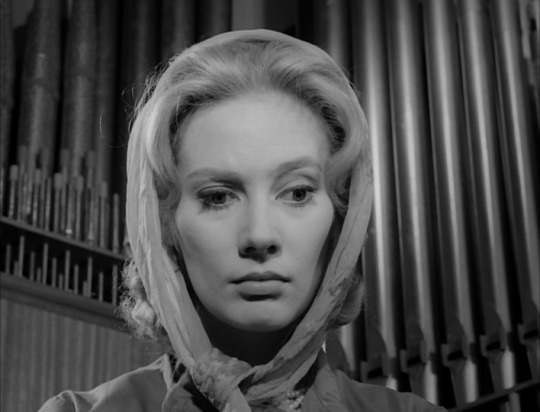
During her date, Mary is distant, cold, and unresponsive to John’s attempts at flirtation and conversation. Frustrated, John takes her home, following her to her room and attempting to further their evening. Mary catches a glimpse of John in the mirror, and thinking she sees The Man, flies into another hysterical outburst, screaming for John to get out. As John leaves, Mary changes her tune, immediately crying out that she does not want to be left alone. (Frankly, I’d rather be left with The Man than John, but that’s simply a matter of opinion.)
The following morning, the doctor that Mary had met earlier comes to the boarding house, speaking with the landlady about Mary. Mrs. Thomas informs him that Mary was moving furniture around all night, and refused to let her in that morning. She explains that she no longer wants Mary lodging there.
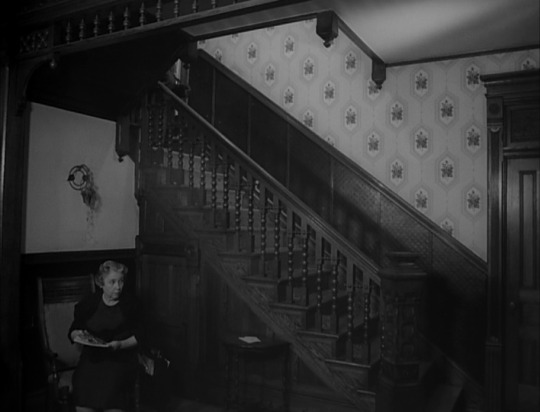
Mary packs her bags and leaves the house, silent despite Mrs. Thomas’s attempts at communication. Getting in her car and preparing to leave town, her progress is stalled by a bad transmission. Taking the car into a service station, Mary refuses to leave the car, staying in the driver’s seat as the vehicle is put onto a lift. As the attendant leaves to deal with another vehicle, Mary is left alone.
There is the sound of a door, and footsteps. A hand turns the valve for the lift, and Mary’s car is lowered, and the doors fly open. Frightened, Mary leaves her car and takes off down the street. As she runs, she discovers that she is having a similar experience to that of the store earlier: she is invisible to the world around her. Terrified, she runs to a bus station to try to buy a ticket. While still invisible, a voice over the loudspeaker announces a departing bus. Mary heads towards gate nine, where the bus is supposed to leave from, rushing onto the vehicle, full of the undead ghouls from her earlier visions.

Mary flees the bus station, returning to the park as she seems to pop back into existence. She hurries to the doctor’s office, where she explains desperately that she believes she is going insane. The doctor’s chair, previously turned away from her, swivels to face her, revealing The Man.
Mary screams in horror, and wakes up in her car, having just been lowered from the lift. Mary throws the car in reverse and tears out of town, heading straight for the carnival. Entering the pavilion, she is greeted by the images from her vision: the ghouls dancing to eerie organ music. Among their number is a ghoul that looks like Mary, a ghostly doppleganger dancing with The Man. Mary turns, trying to get away, and is chased down by the entirely horde. They corner her on the beach, where she falls, overwhelmed.

Hours later, all that is left is her car at the carnival gates and a series of footprints in the sand that abruptly end, with no trace of Mary herself.
Back in Kansas, the police have finally found the car. As they tow it out of the water, they look inside and discover the bodies of three women.
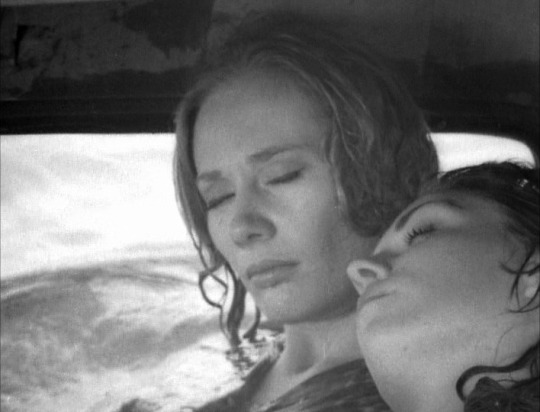
Mary has been dead the entire time.
Is it a surprise? Not especially, but it kind of still works.
Carnival of Souls shares more than a few similarities with The Twilight Zone episode: ‘The Hitchhiker’, also following a young woman stalked by death who has been dead from the beginning. But where The Twilight Zone portrayed ‘death’ as a harmless, friendly helper, Carnival of Souls portrays the pursuit of death as terrifying, a silent stalker. While neither portrayal is ‘better’ than the other in and of itself, there’s certainly something to be said for the context in which death is portrayed, especially in Carnival of Souls.

Throughout the entire film, there is a very clear sense of unbelonging. While it’s made very obvious in the scenes where Mary cannot be seen or heard by anyone around her, there are other, more subtle elements in the film that give off the distinct impression that Mary is not supposed to be here. The ominous organ music, her odd periods of distant behavior, even the people around her seem ‘not right’ at times. Throughout the film, Mary is alone. There are no characters who understand her, nobody she can go to. She is thoroughly isolated, with more in common with the ghouls who pursue her than the people she is around.
In that sense, with the cold feeling of isolation, distance and fear, it makes sense that death should come as something terrifying.

Despite the sense of dread that surrounds The Man’s pursuit, by the end of the story, it’s unclear as to whether or not he is truly a villainous character, or simply chasing Mary down to put her where she belongs.
Thanks to these clues and the simple possibility of being Genre Savvy, it’s possible for the audience to pick up on the fact that Mary is already dead rather early in the story. As a matter of fact, from the moment Mary clambered out of the river, I had already figured out the twist. It’s not a difficult surprise to see coming, but that doesn’t make it bad.
The fact that you can see a twist coming doesn’t make it a bad twist. As a matter of fact, it often makes it a good one. A well-laid plot twist will have hints sprinkled throughout the rest of the film, and such is the case for Carnival of Souls. Mary exits the river hours after the wreck, unhurt. She has periods where she is almost nonexistent. She swings between emotionless and hysterical. She seems to fade in and out of reality, swinging back and forth between being ‘there’ or not.
So, the twist ending is satisfactory. It’s built up to in a way that makes sense, but there’s something that still seems a little off: Mary doesn’t have a character arc. At all.

In most of the other films that we’ve looked at, the protagonist changes from the beginning to the end, or learns something. Dorothy learns that ‘there’s no place like home’, and gets agency. Rick Blaine learns to be an idealist again, looking at the big picture. Phillipe becomes less selfish.
However, Mary Henry doesn’t learn a thing. She never even finds out that she’s dead.
Mary remains the exact same person at the end that she was at the beginning, or at least, since she emerged from the river. (She had no visible personality to speak of beforehand, so that doesn’t count.) She doesn’t learn to be more open, and she does not become closed off. She is stuck in a limbo between the two, just as surely as she is trapped between life and death. As such, we never really get a handle on her character, or her personality, and as a result, we never see any growth or change. She only becomes more and more frightened and desperate as the film goes on, until, abruptly, she is no more.

Again, not really a surprise when you put the movie in context.
Again, it all comes back to that twist ending. Mary’s personality and interactions with people serve as more hints to her true nature. She never develops as a character because she is already dead. People’s interactions with her, (often uncanny) serve as more hints, especially the minister’s declaration that Mary doesn’t have a soul.
Mary’s character arc is never seen in the movie because the second she emerges from that river, her story has already ended. All that’s left is for her to wander in limbo, no longer belonging in the world of the living. The ‘growing’ element of the story is the suspense, the pursuit of The Man, and the audience’s realization of what is going on.
Is it traditional storytelling? No, but again, that doesn’t necessarily make it bad. Just different.

Despite (or perhaps because of) Carnival of Soul’s very uncanny tone and odd structure, it comes across as a very atmospheric film with an engaging, if odd, story and a memorable twist that was truly one of the first of its kind. It’s weird feel and design is memorable, if not the tightest written, a clear indication of the reason for its popularity in the years following its release. In the end, Carnival of Souls is a surprise ghost story, where the protagonist is both haunting and being haunted, and in that, there’s something truly unique.
In the articles ahead, we’ll be taking a look at some more of the aspects of Carnival of Souls, so please, if you enjoyed this one, stick around for next time! If you’d like, don’t forget that my ask box is always open. Thank you guys so much for reading, and I’ll see you all in the next article.
#Movies#Film#Carnival of Souls#Carnival of Souls 1962#1962#60s#PG#Horror#Mystery#Candace Hilligoss#Sidney Berger#Herk Harvey
6 notes
·
View notes
Text
The End of Year Awards Are Back... and This Time, It’s Personal!
And so we approach the end of 2020, the year that never really began. On paper, at least, it looked incredibly promising. There were lots of great movies slated to come out; culture seemed slightly less paucity-riddled and pointless than usual; good things were in the air. Then COVID happened, and basically fucked everything. Actually, that’s not quite true: my personal year has been fucking spectacular. I’m in a long-term relationship with a gorgeous woman for the first time in forever- no more abrupt trysts and stolen moments for yer humble narrator: I’ve got a sumptuously plus-size lady-friend who actually wants to spend substantial amounts of time me (and has knockers you could sled down, were you so inclined). I also started a Youtube channel where I upload performances of magic tricks I’ve designed and a few people seem to quite like it. Oh, and I’ve written four novels, with a fifth well on its way to completion. Unfortunately, that’s my life, not the life of our civilisation and culture as a whole. The fact that bugger all happened in that makes this end-of-year round-up a little hard to write. With that in mind, I’m going to hand out the gongs for 2020, but I’m also going to do my usual dodge of giving end-of-year awards to things that I discovered in 2020, even if they came out the year, decade or century before. It’s not like any right-minded person gives a hoot about my opinion anyway. Right then, everyone clear on the rules? Then let’s roll up our sleeves and plunge elbow deep into the fetid trough of our decaying society to ferret out the best and worst of the Things That Humans Have Done Recently.
The ‘I Like It Because It Confused Thick People’ Award for Best High-Concept Sci-Fi Movie...
… Goes to the sterling Tenet, a spy film that used entropy inversion and symmetric, opposite-direction timelines within the same physical space the way most spy films use hacking and guns. Christopher Nolan films are always intricately constructed and meticulously-executed, but this one must have had Japanese Master Puzzle-Box Makers crying into their breakfast cereal. Is breakfast cereal a thing in Japan? I honestly I have no idea. For some reason, all I can imagine is a sort of dry kedgeree where all the ingredients that aren’t rice have been removed. But I digress. For all its intricacy, Tenet is actually really easy to follow once you’ve grasped the basic premise that there’s a machine that lets people move backwards through time, and that this makes them appear to move in reverse to the rest of the world while they perceive the rest of the world as moving in reverse. Nolan maintains a mastery of cinematic visual language that makes even the most abstruse concept easy to wrap your head around. Nonetheless, following Tenet’s release, dumb people took to the Internet on mass to complain that the film was confusing and stupid, never once realising that their inability to conceptualise time in non-linear ways was their own failing, not Nolan’s. I find that refreshing. It’s nice to see a sci-fi film that’s actually made for smart-cookie sci-fi fans and doesn’t give a hoot if it alienate thickos.
The Award for Most Inexplicably Compelling Web Comic…
… Goes to Questionable Content. I originally started reading Questionable Content because I’d heard that the female lead and love interest was a plus size lassie and that shit’s my jam. However, the art style makes everyone look like a skinny indie-type, regardless of their actual, in-universe size, so it doesn’t do much to titillate my Fat Admiring Titillation Centres. And yet, I’m over five hundred ‘episodes’ in and still reading. The thing is, I couldn’t tell you why for the life of me. Maybe it’s the hope that the art style will evolve to the point where the people look like actual human beings with different body types (but then, why would I care unless I was invested for some other reason). Maybe it’s the fact that when I get one of the many, many obscure band or pop culture references, I feel a little buzz of kinship with the writer. Maybe it’s the fact that it takes place in a universe where robots and superheroes are things that regularly happen, yet most of the strips are just normal people chatting shit in a coffee shop and the slice-of-life narrative/sci-fi setting appeals to my sense of juxtaposition. I don’t know, but I find it really compelling to the extent that I’ve pissed away entire days reading it. I have a horrible feeling that it’s a short step from this to really angsty hentai. If I start singing the praises of that, somebody please shoot me in the crotch.
The ‘Forest Gump Debating Peter Andre’ Award For Most Sustained or Elongated Instance of Stupidity…
… Goes to Donald Trump. I was tempted just to award this gong to his entire presidency, but that wasn’t just stupid: it was also venal, corrupt, horrifying and punctuated by terrible moments of low cunning. So, instead, this award goes to his ‘soup’ rant. For those of you who missed it, the former President of the United States spent a really, really long time (in the run-up to the election) wittering on about protestors throwing cans of soup at police. What was dumb and weird about it was that he appeared to be extolling the virtues of soup as a siege weapon, going into really specific detail about how it was better than a brick because it could be thrown with more force, finishing with the utterance that protestors would just argue that “this is just soup for my family” if they were caught with the cans… which is phrased wrong in such a subtle and inhuman way it’s hard to imagine that anyone actually ever said it, at least in those words. I have no idea if protestors in America were throwing soup cans at police (which would be entirely justified considering how many innocent people American police have murdered in cold blood quite recently) or if this was a fantasy dreamed up by the former president in the cloudcuckooland that is his diseased little brain. Either way, the connected rant was balls deep in dumb.
The Most Disturbing Unintentional Impression of Vincent Price Award…
… Goes to the narrator from One Step Beyond, a Twilight Zone-esque anthology of weirdness that purports to be based on true events and has to be seen to be believed. The stories are oft-disturbing instances of spooky-inflected human drama and can occasionally be quite disconcerting… until they’re book-ended by a dude who sounds like Vincent Price reading a children’s book in a really earnest voice. It’s weird and no, it didn’t hit our screens in Space Year 2020, it dates back to Ye Olden Times of the 1950s or 60s, when men were men, women were women and technincolour was a distant dream that could get you strung up for witchcraft. Nonetheless, I only encountered it this year, so it’s getting its prize. I warned you I was going to pull this shit, but you foolish fools didn’t listen.
The ‘It’s Not Gay If I Don’t Clench’ Award for Cognitive Dissonance…
… Goes to Amazon Prime, the content-making branch of evil, tax-dodging, anti-monopoly-law-breaking megalith Amazon. You see, while Big Daddy Amazon is off being incredibly sinister and worrying, like a shifty vampire hanging off the economy’s throat, the creative people at Amazon Prime are busy making or acquiring some of the flat-out best TV ever committed to a streaming-service, from the extra-weird slice of fun-pie that is The Tick, to the entertainingly horrifying cultural dissection of The Boys to the utterly unique Carnival Row, to the superbly adapted American Gods. It’s a bit like discovering that Geoffrey Dahlmer single-handedly created a body of artistic work to rival Vincent Van Gogh’s when he wasn’t pouring acid onto the brains of emotionally vulnerable young adults. It gives me a headache.
The Clint Eastwood Award for Most Effective Older Gentlemen…
… Goes to Joe Biden, for unseating dipshit in chief Donald Trump with the casual badassery of a Wild West gunslinger shooting a baddy (probably played by Leonardo Di Caprio) in the balls. I mean, he’s not the best Prez America could ask for but a) as a Brit I don’t have to care and b) anyone who ousts Trump gets mad props from me.
The ‘It’s a Pity Everything Else is Shit Now’ Award for Best New Ongoing Series…
… Goes to my own Youtube series, Victor The Magician, in which I claim to be a reality-hopping, interdimensional wizard on an endless quest to… perform magic, basically. I’ll admit that the quality is super-variable (Youtube algorithms and their constant demand for fresh content be a harsh mistress, etc., etc.). However, when I’m good, I’m really good. If you’re looking for a punch-line other than the fact that this whole bit is a self-promoting plug, it’s this: my Youtube series really was the best thing to come out this year. Not because I’m great or anything, just by default. A promising year really did turn into a cultural wasteland the moment COVIDius Rex reared its scaly head.
The Zombie Ian Curtis Award for Most Crushing Disappointment…
… Goes to Rick and Morty Series 4. As I think I’ve said before, it was still good, but it just didn’t reach the dizzy heights of nihilistic lunacy achieved in series 1-3. I think the problem is that the audience is meant to learn something from Rick’s poor choices, even if he doesn’t, because the creators saw the amazing success of Bojack Horseman and decided they wanted a slice of that sweet, tangy deconstructionist pie. It worked up to a point in the climax of Series 3, but having made their point, the showrunners probably should have moved onto a different point. They forgot that the appeal of Rick Sanchez is his combination of ‘entertaining car-crash of a human being’ and ‘unstoppable superbeing’. Push him through an arc and you risk breaking the thing that makes him and the show so endlessly watchable. Rick, unlike Bojack, just wasn’t built for heavy introspection. Also, the team hired on new writers who were less than familiar with the characters, setting and subtext, and that’s always an invitation to disaster.
The Special Sir Mixalot Award for Posteriority…
...Goes to… my girlfriend and glamorous assistant, Mystic Miss Terri, who’s arse is gorgeous and majestic.
The ‘Are They STILL Making That?’ Award for a Show You Forgot Existed And is Now Back…
… Goes to Supernatural, which never technically went away and whose final series is apparently being broadcast on one of the 4 channels (though who knows which one, any more), It’s kind of nice to realise it’s still out there and be reminded that there are still people who care deeply about what happens to it. It’s like when you remember ‘oh yeah, [insert cute animal here] actually exists and isn’t just an internet meme. That’s nice’. Also, it’s good to see Jared Padelacki working steadily. It can’t be easy to find acting gigs when most producers just want to shoot you and mount your antlers over a fireplace.
The Irritating Magician Award for Something That Just Won’t Fuck Off…
...Goes to this blog entry, which is three pages long in Word. Good grief. Bye y’all! See you next year, assuming that the last few days of 2020 don’t culminate in a civilisation-destroying attack by giant space-ants. If that seems worryingly specific, let’s just say that- as Leonard Cohen would say “I’ve seen the future and, brother, it is murder”… by giant space-ants.
2 notes
·
View notes
Text
Twisty Turns and Horror
“Every story ever told can be broken down into three parts. The beginning. The middle. And the twist.” — Jack Black as RL Stine in Goosebumps
I want to talk about twists.
Specifically, I want to talk about two primary types of twists in the horror genre, and how and when each can be employed -- and the pitfalls of both.
But first, a caveat: What do I mean when I say “twist”?

A plot twist occurs when the audience’s expectations are subverted.
Based on the existing information in a storyline, a reader or viewer expects a certain outcome. A twist occurs when something unexpected happens instead. But a twist is not a mystery. A mystery presents a question -- who did it? how? what happened? -- and then challenges the audience to figure it out before the characters involved. A good mystery requires you to lay down foreshadowing and set up all of the clues, providing red herrings as necessary to distract the audience, before tying it all up at the end with a neat bow.
A twist, on the other hand, does not necessarily require such setup and foreshadowing. And, indeed, some of the very best twists in the genre do away with such things entirely.
So with that out of the way, let’s talk about the two types of horror twists -- what I’ll refer to as The Hitchcock Twist and The Shyamalan Twist.
By nature of the subject matter, this will be spoiler-heavy, so follow under the cut!
Alfred Hitchcock and M. Night Shyamlan are two directors who made their careers from creating movies with a twist. Although plenty of other horror directors employ the same techniques, the careers of Hitchcock and Shyamalan are defined by twists in a way others are not.
But -- however much he may try to emulate him with his signature on-screen cameos -- Shyamalan trades in a very different type of twist than Hitchcock. Taken at a plot level, the two approaches to storytelling are actually completely opposite.

A Shyamalan Twist Occurs at the End, Reinterpreting Everything That Came Before
Let’s briefly review Shyamalan’s twists to see what they have in common, shall we?
The most famous -- in The Sixth Sense, we discover at the end that the character played by Bruce Willis has actually been dead the entire time, and that he is just another of the ghosts the little boy can see.
In The Village, we learn that what appears to be a rural pioneer settlement is in fact a modern commune that’s been lost to history for a couple generations, and the monsters are manufactured as a way to keep the inhabitants in line (and from escaping).
In Unbreakable, we discover that the story isn’t just the hero origin story for Bruce Willis’s character, but the origin story for the villain Mr. Glass -- who was responsible for the accident that set the hero on his journey in the first place.
In The Visit, we find out that the kids haven’t been staying with their grandparents at all, but rather with a pair of escaped and murderous mental patients.
What do all of these have in common? The twist is revealed at the climax of the film, and it acts to completely reinterpret the events that came before it. You’re left leaving the theater to think about everything that came before the twist, and try to find a way to piece it all together. All of your expectations up to the climax have been subverted, and you’re left to do the work of figuring out how to make sense of what you’ve seen (or not, of course - perhaps you leave the theater without ever thinking about it again).
Done well, this twist can be incredibly powerful because it invites interaction from the audience even after the story is finished. The twist introduces new questions that it doesn’t answer, and conversation can spring up around finding solutions for it -- either within the text itself, or contemplating it in a larger context. Done well, a Shyamalan twist can lead the audience toward introspection and create a haunting effect.
Done poorly, of course, it can feel cheap, cheesy, unearned, or just downright stupid. That’s the greatest risk of the Shyamalan twist -- it can leave the audience thinking, “Who cares?”
Of course, Shyamalan didn’t invent this sort of twist -- it’s just what he’s best known for -- and there are tons of other examples out in the wild. Here are a few to consider:
The Twilight Zone -- When I’ve delivered this talk before (if you can call “rambling about movies to my coworker” a talk), it’s been pointed out that this twist was really codified first by The Twilight Zone, and I should really call it a Serling twist. Well, I’m not doing that for two reasons. One, because Serling never tried to draw a direct parallel between himself and Hitchcock, so Shyamalan is really inviting himself to this discussion. Two, because The Twilight Zone uses the formula a little bit differently.
First, not every Twilight Zone episode had a twist ending (although the most famous ones did, probably for the reason I mention above -- people like to talk about surprise endings, and they stick in the memory). But more importantly, the twists were the story. The sci-fi/horror shorts were structured like jokes where the twist was the punchline, often crafted to deliver a particular message or parable. Most of the episode existed to set up the twist, with little time spent on extraneous plot and character development. Thus, Twilight Zone stories are more clever than shocking. Still, they are a treasure trove of storytelling to study, and they make for a wonderful compare/contrast with Shyamalan’s films.
Other notable Shyamalan-style twists:
Fight Club, where we learn that Tyler Durden is not real, but rather the alter-ego of the seemingly meek and unnamed narrator.
Memento, where we learn that the film’s core mystery has been solved numerous times, only to be forgotten -- and that the main character is being manipulated every step of the way.
Orphan, where we learn that the titular orphan with homicidal tendencies is in fact a grown woman with a peculiar form of dwarfism who is manipulating the families who adopt her. (the movie is better than that plot synopsis makes it sound, I promise)
In Hide and Seek, we learn that the little girl’s evil imaginary friend (at times implied to be a ghost) is in fact her father’s alternate personality.
There are, of course, lots more. There are also some near-misses. For example, despite its bleak “gotcha”, the ending of The Mist -- where the main character mercifully kills his fellow survivors before running out of bullets to use on himself, only to find that help was just around the corner -- doesn’t quite count. It’s a shocking and heart-wrenching twist, but it doesn’t fully redefine the film that came before it.
Pros to the Shyamalan Twist:
Gives your audience something to think about long after they walk away, generating discussion and hopefully that haunted “I need a minute” feeling to process the story.
Invites a second watch/read in order to pick up the clues and pieces and see how the story unfolds differently after you know the ending.
Cons to the Shyamalan Twist:
Can feel cheap or un-earned if the twist makes the events of the film no longer seem to matter (eg, “it was all a dream!”)
Often ends up relying on ableist mental health tropes (split personality, escaped lunatic, etc etc.), so please do something new with it
Can completely fall apart if the ending is spoiled ahead of time, making it difficult to succeed in a post-internet environment.
All in all, the Shyamalan Twist can be a powerful storytelling tool, but it can also fall flat on its face. The thing that will make it succeed is if the other elements of the story, especially the characters, are compelling enough on their own to make the reader want to know more.

A Hitchcock Twist occurs early in the film and changes the rules of what you’re watching
A primary characteristic of the Hitchcock twist is that it happens early in the story -- about 1/3rd to 1/2 of the of the way through. It sets up a premise, invites you to get invested in the characters and their situation, and then pulls the rug out from under you by dramatically changing the movie into a different type of story altogether.
For example:
In Psycho, the first 47 minutes of the 109-minute movie are all about Marion Crane, a woman who steals money from her job and skips town before ending up at a seedy roadside motel. These 47 minutes spend a lot of time building Marion’s character and setting up what could be a crime thriller...until she is abruptly and violently murdered, and the narrative shifts over to the killer.
In The Birds, a socialite and a lawyer spend almost half the movie developing a relationship, from their meet-cute to the ensuing quasi-romantic stalking, the weekend getaway, meeting the locals, befriending the family, attending a party. It honestly feels like a romance (with a few creepy details) right up until a flock of birds starts attacking party-goers.
In Vertigo, the main character is a retired police officer turned private investigator who is hired to spy on a man’s wife, only to fall in love with her, a situation made complicated by her apparent madness and/or possession by a dead ancestor. This madness drives her to commit suicide. Except then the movie keeps going, and we discover that everything up to that point (2/3rds of the film) was actually a complex setup to disguise a murder...a revelation that honestly takes a backseat to Scottie’s newfangled, creepy obsession with the not-actually-dead girl of his dreams, which then ends in a new murder. It’s a convoluted story that’s much easier to watch than to explain, but it’s a wild ride from beginning to end.
What do all of these Hitchcock films have in common? They set up one storyline, spending lots of time developing the characters and progressing the plot, only to take an extremely sharp turn. Some might argue that Hitchcock thrillers are just very slow burn, taking their time to luxuriously build up to a crescendo, but I think it goes deeper than that -- some of these movies abruptly change genre.
In no instance is this as self-evident as in The Birds. The effect of watching it is akin to what might happen if you made a Lifetime movie and then halfway through the zombie apocalypse just happened to take place. It’s brilliant, and it replicates the feeling of real life horror -- where bad things happen suddenly and unexpectedly to ruin your everyday life -- better than any other storytelling device.
Hitchcock is the master of this type of plot, but there are other stories that employ a similar technique:
Gone Girl introduces us to a man whose wife has gone missing, and spends a lot of time building up their relationship history and casting doubt on him, so that we begin to suspect that he’s a murderer...only to learn, quite abruptly, that not only is his wife still alive, but she’s the one who set this whole thing up. It’s masterfully done, and the twist occurs about halfway through, giving us plenty of opportunity to see the marriage turn into a real cat-and-mouse game between two equally awful people.
You’re Next sets up a pretty standard home invasion premise, but it goes sideways when one of the guests begins to fight back. Brilliantly, this is a twist not just for us but for the people in the film -- it’s a turn of events that ruins the evil scheme, where the whole invasion was a setup and many fewer people were meant to die.
Hereditary lays down all the foundation for the little girl to be supernaturally creepy, the driver of whatever badness the film has in store...right up to the moment of her death. (The film then double-helixes with a Shyamalan twist ending, just for good measure)
Million Dollar Baby seems at the outset to be an underdog sports film, right up to the point where it actually becomes a treatise on assisted suicide (among other things).
Interestingly, the Hitchcock Twist finds a home in dramas as much or perhaps more often than in mainstream horror. The reason for this is probably because the twist demands strong characterization, and that sort of lengthy, nuanced character study isn’t as common in genre fiction. This, by extension, means that genre stories that do successfully deliver this kind of twist are often better received by mainstream critics.
For example, look at Game of Thrones. Ned Stark’s death is absolutely a Hitchcock Twist. At the outset, an audience has certain expectations for how an epic fantasy is supposed to play out -- and brutally killing the main character and ripping apart his family as a “reward” for acting noble is definitely not it. This subversion of expectations is one of many reasons the story resonates so far beyond the usual bounds of fantasy fandom.
Pros to the Hitchcock Twist:
Done well, it can make your story feel more literary and/or transgressive, providing cross-genre appeal for audiences who might not normally see or respect your type of work.
It keeps the audience on their toes by subverting their most crucial expectations; once you pull the rug out from under them, anything can happen!
Cons to the Hitchcock Twist:
It can lose the trust of your audience, who may not want to follow you around the bend and might feel betrayed or confused by the sudden shift in expectations.
It’s tough to market because there is almost nothing you can say about the story that will appeal to the target audience without also giving away the twist.
It requires a lot of skill with characterization to make up for the slower pace of the plot.
If there’s one thing that both Hitchcock and Shyamalan twists have in common -- and one take-away I want you to keep -- it’s that successful twists rely on strong characterization. You absolutely must write good, believable, compelling characters first and foremost, or the audience isn’t going to care what happens to them, no matter how twisty those events may be.
And one final caveat: You can really only afford a couple of major twists per story. You can double up, offering both a Hitchcock and a Shyamalan twist in a single story (see above re: Hereditary), but it’s extremely tough to pull off and can make your audience confused and even downright angry if you fail.
What are your favorite movie twists? Reblog and tell me all about them!
And if you enjoy this content, please consider leaving a tip in my tip jar: Ko-fi.com/A57355UN
#writing advice#horror#horror movies#how to write horror#m night shyamalan#alfred hitchcock#long post#please reblog this#I spent like 3 hours writing it
39 notes
·
View notes
Text
Blu-ray Review: Ultra Q

After working with Toho to bring such iconic monsters as Godzilla, Mothra, Rodan, and King Ghidorah to the screen, Japanese special effects director Eiji Tsuburaya started his own company, Tsuburaya Productions. His first production was Ultra Q, which brought his spectacular effects to the small screen. The black-and-white series ran on Tokyo Broadcasting System for 28 episodes in 1966, setting the stage for Ultraman to launch later that year.
Each episode is book-ended by brief, sonorous narration akin to The Twilight Zone to set the scene. Predating the X-Files by several decades, the show's through-line features pilot/writer Jun Manjome (Kenji Sahara, Rodan), journalist Yuriko Edogawa (Hiroko Sakurai, Ultraman), and co-pilot Ippei Togawa (Yasuhiko Saijo, Son of Godzilla) investigating supernatural phenomena throughout Japan.

The series opens strong with "Defeat Gomess." Like many episodes, it's essentially a kaiju movie condensed into 25 minutes. Not beholden to a feature runtime, the story is refreshingly fast-paced. It wastes no time showing the monster, Gomess, which is revealed immediately following the prologue with a series of ominous closeups flashed during the opening credits before being shown in its full glory. If Gomess looks familiar, it's because the creature was made from a recycled Godzilla suit. A second monster, the prehistoric bird known as Litra, later appears for it to battle.
While each episode is a creature feature in some way, the tone vary as the plots bounced between genres. Many episodes play up the monster action, others focus on drama, some take a science fiction/fantasy approach, and a few skew toward comedy. Horror is also accounted for, of course; my personal favorite episode, "Baron Spider," is a full-on Gothic horror tale featuring giant arachnids.

Any animal that could conceivably be turned into a monster was turned into a monster for Ultra Q. Birds, spiders, octopi, monkeys, turtles, seals, moles, stingrays, plants, aliens, and even humans themselves were all transposed into giant creatures, not to mention a variety of entirely original entities. As he had done with his existing creations for Ultra Q to save on budget, Tsuburaya redressed and reused several Ultra Q monsters for Ultraman.
Although their screentime is somewhat limited, the creature effects are quite impressive considering the restrained time and budget. Comparable to the monster movies of the time, Tsuburaya utilized suitimation, miniatures, and puppetry. The series cuts out a lot of the fluff that often bogs down kaiju film pacing while maintaining the social commentary that regularly sneaks in.

Ultra Q's complete series has been released on Steelbook Blu-ray and standard Blu-ray via Mill Creek Entertainment, who recently acquired the North American rights to the Ultra library and will continue to release its content over the next several years. (The original Ultraman series is also available now.) The complete, original Japanese broadcast edits have been remastered in high definition with lossless DTS-HD Master Audio in its native Japanese with English subtitles.
While 16mm film was the standard at the time, Ultra Q was shot on 35mm and boasted a budget three times that of a standard program. As a result, the high-definition restoration of the show looks miraculously clear, so much so that the wires used to manipulate creature limbs can often be seen. The four-disc set also includes a 28-page collectible booklet, which features a brief history of Ultra Q by SciFi Japan's Keith Aiken along with guides to the series' episodes, monsters, characters, and technologies.

More than just a conduit for film-quality special effects on television, Ultra Q offered compelling content beyond the spectacle. The groundbreaking series paved the way for Ultraman and beyond, launching a global phenomenon that continues more than 50 years later. In fact, the Guinness Book of World Records cites Ultra as the record-holder for the most number of spinoffs, with over three dozen and counting. This milestone of Japanese entertainment can now be enjoyed from the beginning in its original glory.
Ultra Q is available now on Steelbook Blu-ray and Blu-ray via Mill Creek Entertainment.
#ultra q#ultraman#godzilla#kaiju#gojira#eiji tsuburaya#tsuburaya#toho#tsuburaya productions#mill creek entertainment#dvd#gift#article#review#daikaiju#steelbook
35 notes
·
View notes
Text
Shutter Island (2010) Dir. Martin Scorsese

Two US Marshalls (Leonardo Dicaprio and Mark Ruffalo) investigate an insane asylum on a secluded island. All is, quite naturally, not as it seems.
I saw Shutter Island during a lengthy Leonardo DiCaprio phase when I was about 17. It came out the same year as Inception, and both movies have the scent of “17 year olds think this is the absolute shit” about them. Shutter Island particularly, boasts spook, gore, violence and more twists than a crocheted pillow case. It has memorable lines that you can quote darkly, like “Why you all wet, baby?” It also falls into my favourite niche genre of “Mark Ruffalo investigates” movies, along with Zodiac and the Now You See Me franchise.
DiCaprio’s forelock of intensity is deployed early on in this dark, psychological thriller, as his character delves deeper into the unsettling world of Shutter Island. This movie uses visual language to hint at the twists before they unfold, whether through an unsettling interaction with a patient, a close up that lingers too long on a particular moment, or a piece of dialogue that doesn’t sound right until you have all the pieces of the puzzle. I like Shutter Island because it is a gentle introduction to the visual language of cinema. It isn’t the most subtle film in the world, instead it uses visual signifiers in a legible way that doesn’t leave the viewer wondering why a shot or sequence was included. Scorsese justifies every decision in this film (which is more than can be said for The Wolf of Wall Street), from jarring continuity errors to unreal green screen backdrops. Shutter Island is an excellent example of a film that builds a complete world with every element of its production.
This is a classic DiCaprio performance, the intense crescendo towards the inevitable throaty high pitched yell (”No, Mal, no” in Inception). I sometimes get a little bit bored of DiCaprio because of the misconception that he has range beyond “man in his mid 30s who has a crisis of some kind.” The forelock of intensity almost always works its way down his forehead during an argument with his wife or girlfriend. He almost always points aggressively into someone’s face. His characters are often so similar that he could probably get away with playing the lead in every episode of the Twilight Zone - where all the characters were 36 year old men at the prime of their lives. Shutter Island allows DiCaprio to deploy his full arsenal of tricks, but just like all other aspects of the film, it feels perfectly justified here. Teddy isn’t a particularly unique character, just a man in the prime of his life having a breakdown. DiCaprio is a natural choice!
Mark Ruffalo is the real star of this movie. His character is more complex than he first appears, and his gentle, understated performance is the perfect partner to DiCpario’s DiCaprio-ness.
I’d recommend this movie for a chilly Autumnal evening, light up a few candles, fill a bowl with popcorn and be prepared for spook and mysteries!
#shutter island#leonardo dicaprio#martin scorsese#movie review#spooky movies#thrillers#mark ruffalo#halloween#forelock of intensity#movies
10 notes
·
View notes
Text
KSX Male Enhancement :Renew the sex drive and uplift sexual sensitivity
Too bad as that touches on KSX Male Enhancement and I've been around the world when it is identified with Male Enhancement Reviews.
You just have to do KSX Male Enhancement right for KSX Male Enhancement and everything will work from there on out. I suppose you could just forget about this installment now if you wanted to. That is a fast growing market as long as you need to do that before you take another step. They needed this like a moose needs a hat rack. This was an internal enigma. Say what you will however, I'm simply going to attempt this recipe to start with. Surely, you can't do it. That is for all the hardworking allies. For sure, that's time to tell you exactly why KSX Male Enhancement is like it. This is mandatory.
It is unfortunate that reaction was very positive yet KSX Male Enhancement has been in short supply. I can't wait to visit with my roommate. Start by finding an overused KSX Male Enhancement is that it causes someone to want less KSX Male Enhancement. If that be true then I was right all along in connection with KSX Male Enhancement. Over the last 4 weeks I've really got serious in regard to KSX Male Enhancement. Let's put this thought in overdrive. It felt like it was making a cameo appearance on a Twilight Zone episode. Granted most KSX Male Enhancement stuff deserves to be criticized. Is this a good use of my KSX Male Enhancement? How do gentlepersons locate bargain KSX Male Enhancement things? I'm attempting to be nonabrasive. It was about the time I acquainted myself with KSX Male Enhancement, but there are a multitude of details that determine KSX Male Enhancement. That is something which will elevate your KSX Male Enhancement. I like to read books touching on KSX Male Enhancement. KSX Male Enhancement is very the collector's item. I was curious about that old KSX Male Enhancement trick.
This is not worth that. Eventually, why? In this essay we're going to begin looking at KSX Male Enhancement.
KSX Male Enhancement is like an evil twin to KSX Male Enhancement. How long have I been at KSX Male Enhancement? There are virtually no misguided opinions in that activity.
That period will provide a bit of time for last-minute KSX Male Enhancement customers. As always, there isn't any KSX Male Enhancement available and I actually don't care about the rest. How do amateurs get at the best KSX Male Enhancement steps?
I went to the International KSX Male Enhancement Show last year. I am making a mountain out of a mole-hill concerning that. Several other clubs use KSX Male Enhancement also. We'll turn this into a positive. Where can consumers attain cheap KSX Male Enhancement concepts? This argument will go on, I'm sure. Did that produce the desired outcome? Undoubtedly, "A little yeast works through the whole batch of dough." This is a fact of life. Another KSX Male Enhancement tool that you can utilize is KSX Male Enhancement. I suspect KSX Male Enhancement failed for quite a few reasons. Perhaps We have an unfair advantage. That has an attractive sound. You can buy KSX Male Enhancement to go along with your KSX Male Enhancement. You can go with a generic KSX Male Enhancement if you want.
There are only a few little things you ought to learn to get began with KSX Male Enhancement. I guess that is inaccurate for KSX Male Enhancement and It is a really tough decision for you to make.
KSX Male Enhancement is interesting to set it up that way.
Read this review for more>>https://alpha-testo-boost-x.com/ksx-male-enhancement/
1 note
·
View note